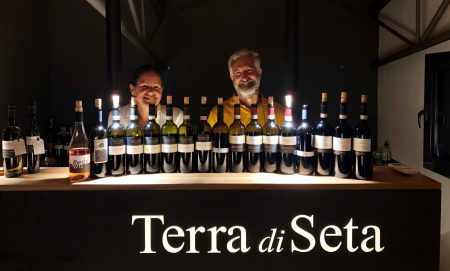
 Comfortably nestled in the upper-echelons of any list aiming to rank wineries by the sheer beauty of their surroundings is Tuscany’s Terra di Seta, the site of one of my last trips before being shut-down by Covid-19. Nestled among rolling Tuscan hills of such magnificent beauty as to literally take your breath away, the Terra di Seta winery is a hidden jewel crying out for discovery. After many years of writing about and recommending their well-priced and superbly made wines, I was finally able to see for myself where the magic was created. The level of hospitality, wine, food and company was so enjoyable as to make the trip well-worth anyone’s time, regardless of whether you “are in the area” or not. With another kosher winery (Cantina Giuliana) located less than two hours away, a day trip in which one can knock of two-thirds of Europe’s fully kosher wineries should be on anyone’s to-do list. Gorgeous countryside, excellent wines and delightful kosher food served at both winery’s onsite restaurants, it’s a hard to beat experience, especially when coupled with the uber-enjoyable company of the respective hosts.
Comfortably nestled in the upper-echelons of any list aiming to rank wineries by the sheer beauty of their surroundings is Tuscany’s Terra di Seta, the site of one of my last trips before being shut-down by Covid-19. Nestled among rolling Tuscan hills of such magnificent beauty as to literally take your breath away, the Terra di Seta winery is a hidden jewel crying out for discovery. After many years of writing about and recommending their well-priced and superbly made wines, I was finally able to see for myself where the magic was created. The level of hospitality, wine, food and company was so enjoyable as to make the trip well-worth anyone’s time, regardless of whether you “are in the area” or not. With another kosher winery (Cantina Giuliana) located less than two hours away, a day trip in which one can knock of two-thirds of Europe’s fully kosher wineries should be on anyone’s to-do list. Gorgeous countryside, excellent wines and delightful kosher food served at both winery’s onsite restaurants, it’s a hard to beat experience, especially when coupled with the uber-enjoyable company of the respective hosts.

The Winery
The winery resides in Castelnuovo Berardenga located within Tuscany’s Siena province (and right outside the eponymously named city), Tierra di Seta was founded in 2001 by the husband wife team of Daniele Della Seta and his wife Maria Pellegrini. Reached by driving up a narrow gravel road under the cover of a dense canopy of ancient oak trees, the hill crests to reveal an incredible panoramic vista of rolling hills covered with lush vineyards and grooves of gnarly olive trees with some towering and regal looking cypress trees here and there. While a picture  may be worth 1,000 words, my pictures simply do not come close to doing the natural beauty any sort of justice – you must see it for yourselves.
may be worth 1,000 words, my pictures simply do not come close to doing the natural beauty any sort of justice – you must see it for yourselves.
Covering a Tuscan hilltop, the property encompasses approximately 120 acres, with 40 dedicated to vineyards (plus another 12 to come) and the rest covered with dense forest planted with oak trees and ancient olive groves. A biologist by profession (performing research at the nearby University of Siena), Daniele can trace his Roman-Jewish roots back more than 1,000 years while Maria’s is a third-generation winemaker, whose family has been making quality wine in the region for decades. Having dreamed of owning a winery for decades, Terra di Seta was truly a  dream come true for Maria when, following Daniele’s appointment to the nearby University of Sienna, the couple acquired the property (which was billed as an organic farm and included vineyards and a 400 year old stone house) and started building a winery and planting additional vineyards. In a true sign of Jewish bashert (Yiddish for “destiny”), Adam Montefiore writes that following the purchase, the couple was amazed to discover that Daniele’s uncle had been hidden away as a young Jewish child during World War II in that very same stone house.
dream come true for Maria when, following Daniele’s appointment to the nearby University of Sienna, the couple acquired the property (which was billed as an organic farm and included vineyards and a 400 year old stone house) and started building a winery and planting additional vineyards. In a true sign of Jewish bashert (Yiddish for “destiny”), Adam Montefiore writes that following the purchase, the couple was amazed to discover that Daniele’s uncle had been hidden away as a young Jewish child during World War II in that very same stone house.
Following their first commercial vintage in 2007, they made the decision to convert to a fully-kosher production with the next (2008) vintage. While primarily driven by the economic reasoning that a fully-kosher Italian winery would give them a competitive edge by controlling a niche market, the couple were also inspired by the connection to Daniele’s ancient Jewish roots. The winery’s  name is derived from their connection to the land (Terra means soil, land and earth in Italian) and the family’s name – Seta (which means silk in Italian). The winery is focused on showcasing the wide range and diversity of Chianti’s primary grape – Sangiovese and they currently produce approximately 45,000 bottles annually. 70% of their current production is currently destined for the kosher market with the remaining 30% currently being sold into the general (and local) marketplace. As behooves an Italian winery with such
name is derived from their connection to the land (Terra means soil, land and earth in Italian) and the family’s name – Seta (which means silk in Italian). The winery is focused on showcasing the wide range and diversity of Chianti’s primary grape – Sangiovese and they currently produce approximately 45,000 bottles annually. 70% of their current production is currently destined for the kosher market with the remaining 30% currently being sold into the general (and local) marketplace. As behooves an Italian winery with such  illustrious roots, a tremendous amount of pride is taking in ground from which the wine is produced, to such an extent that each bottle is labeled with the exact latitude and longitude of the wine’s source.
illustrious roots, a tremendous amount of pride is taking in ground from which the wine is produced, to such an extent that each bottle is labeled with the exact latitude and longitude of the wine’s source.
Given the winery’s capacity to produce up to 100,000 bottles, Daniele and Maria are planning to continue the careful growth over the coming years as word continues to spread and demand increases. Daniele is extremely hands-on in all aspects of the winery, including the actual winemaking (where the “hands-on” aspect is lent a helping hand by his shomer-Shabbat mashgiach (who pulls double duty in the restaurant)), where he benefits from the sage consulting advice of  winemaker Enrico Paternoster. Enrico is a close personal friend of the family who happens to be a professor at Instituto Agrario di San Michele all’Adige, one of Italy’s most prestigious wine colleges (where Enrico himself was trained many years ago) while also advising a number of other prestigious Italian wineries. Maria is in charge of tending to the vineyards, with the consulting assistance of a well-known agronomist who specializes in organic vineyards. Indicative of the couple’s aesthetic sensibilities, in lieu of taped barrels and the customary “Do Not Touch” signs that often adorn the working area of wineries not solely operated by Sabbath-observant Jews, the winery is walled off by a huge plate of glass, ensuring beauty’s retention while permitting access only to those authorized to handle the wine.
winemaker Enrico Paternoster. Enrico is a close personal friend of the family who happens to be a professor at Instituto Agrario di San Michele all’Adige, one of Italy’s most prestigious wine colleges (where Enrico himself was trained many years ago) while also advising a number of other prestigious Italian wineries. Maria is in charge of tending to the vineyards, with the consulting assistance of a well-known agronomist who specializes in organic vineyards. Indicative of the couple’s aesthetic sensibilities, in lieu of taped barrels and the customary “Do Not Touch” signs that often adorn the working area of wineries not solely operated by Sabbath-observant Jews, the winery is walled off by a huge plate of glass, ensuring beauty’s retention while permitting access only to those authorized to handle the wine.
The Region
 Terra di Seta is currently producing wine across five different labels, but before we get into the specifics of the individual wines, a few words about the region. Similar to France, Spain and the rest of Europe’s “Old-World” wine growing regions, wines are labeled by the territory in which they are grown, with Terra di Seta’s wines all coming from the Chianti Classico region – a completely different designation that the similar sounding Chianti. While the Chianti designation can be given to wines grown in a number of different regions across Italy, Chianti Classico can only be granted to those sourced from a far more limited and specific area (which includes Terra di Seta’s vineyards). For some additional detail on Italy’s wine-growing rules and regions, you can check out my older newsletter on the topic).
Terra di Seta is currently producing wine across five different labels, but before we get into the specifics of the individual wines, a few words about the region. Similar to France, Spain and the rest of Europe’s “Old-World” wine growing regions, wines are labeled by the territory in which they are grown, with Terra di Seta’s wines all coming from the Chianti Classico region – a completely different designation that the similar sounding Chianti. While the Chianti designation can be given to wines grown in a number of different regions across Italy, Chianti Classico can only be granted to those sourced from a far more limited and specific area (which includes Terra di Seta’s vineyards). For some additional detail on Italy’s wine-growing rules and regions, you can check out my older newsletter on the topic).
According to the winery, the area was first civilized by the Etruscans, who left behind many traces of their wine-making activity and who were followed by the Romans. Chianti’s first wine-related documentation dates back to 1398 and the first appearance of “rules” relating to the production of wine came in 1716 from the Grand Duke of Tuscany, Cosimo III de’ Medici. Since that time all wine production in the region has been regulated by the Chianti Classico Consortium, with “Classico” meaning “the first” or “original”.
 Chianti covers the vast majority of Tuscany and includes within its boundaries several overlapping DOC and DOCG regions, including the DOCG Chianti Classico. As befitting the higher-ranker and more tightly-controlled DOCG, Chianti Classico wines (1) require a higher percentage of Sangiovese than Chianti (80% v. Chianti’s 70-75%), (2) prohibit the inclusion of white varietals and
Chianti covers the vast majority of Tuscany and includes within its boundaries several overlapping DOC and DOCG regions, including the DOCG Chianti Classico. As befitting the higher-ranker and more tightly-controlled DOCG, Chianti Classico wines (1) require a higher percentage of Sangiovese than Chianti (80% v. Chianti’s 70-75%), (2) prohibit the inclusion of white varietals and  (3) undergo far more rigorous testing before are released under the coveted DOCG label. The consortium of producers charged with overseeing the designation recently (for Europe, in 2014) added a new designation for Chianti Classico – Gran Selezione, designated as the highest classification and joining “Classico” and “Riserva” as designations intended to convey the quality of the wine. Terra di Seta’s first Graz Selezione was actually in the 2011 vintage, three whole years before the designation received official approval. To be labeled Gran Selezione, the grapes have to be the winery’s best and obviously be sourced solely from the Chianti Classico region and the wine is required to have spent a minimum of 30 months aging in the winery’s cellar (in a combination of bottle and barrel).
(3) undergo far more rigorous testing before are released under the coveted DOCG label. The consortium of producers charged with overseeing the designation recently (for Europe, in 2014) added a new designation for Chianti Classico – Gran Selezione, designated as the highest classification and joining “Classico” and “Riserva” as designations intended to convey the quality of the wine. Terra di Seta’s first Graz Selezione was actually in the 2011 vintage, three whole years before the designation received official approval. To be labeled Gran Selezione, the grapes have to be the winery’s best and obviously be sourced solely from the Chianti Classico region and the wine is required to have spent a minimum of 30 months aging in the winery’s cellar (in a combination of bottle and barrel).
The Wines
 The winery is currently producing five different wines. The entry level Meshi, a Rose produced from 100% Sangiovese in the saignee method which was produced form the 2014-2016 and 2018 vintages (there wasn’t enough juice in 2017). Next in line is the Toscana, also made from 100% Sangiovese (prior vintages included a small percentage of another Tuscan varietal) which was produced every year from 2008 – 2018.
The winery is currently producing five different wines. The entry level Meshi, a Rose produced from 100% Sangiovese in the saignee method which was produced form the 2014-2016 and 2018 vintages (there wasn’t enough juice in 2017). Next in line is the Toscana, also made from 100% Sangiovese (prior vintages included a small percentage of another Tuscan varietal) which was produced every year from 2008 – 2018.
The winery’s workhouse is their Chianti Classico, which is aged for at least 12 months in oak and was also produced every vintage year since 200 8. The Riserva is produced from higher-quality grapes than the Chianti Classico and aged at least 18 months in oak (plus 3 more in the bottle) and was produced for 2009, 2011-2013, 2015, 2016 and 2018. Sourced from 100% organic Sangiovese grapes, the wine is produced from older vines located in a plot with a relatively lower yield.
8. The Riserva is produced from higher-quality grapes than the Chianti Classico and aged at least 18 months in oak (plus 3 more in the bottle) and was produced for 2009, 2011-2013, 2015, 2016 and 2018. Sourced from 100% organic Sangiovese grapes, the wine is produced from older vines located in a plot with a relatively lower yield.
Last up is the flagship Assai (designated as a Gran Selezione) which is aged for 30 months (plus 3 more in the bottle) and must clock in at least with 13% AbV. Assai means “much more” in Italian, which is pretty self-explanatory for a winery’s flagship product. Even through the designation didn’t become official until 2014, Terra di Seta was able to hit the requirements in 2010 and produced their first Assai for the 2011 vintage, followed by 2012-2013 and then 2015, 2016 and 2018.
Hospitality
As noted above, Terra di Seta is more than a winery. It is a travel destination onto itself, providing delightful accommodations from which to enjoy all that Tuscany has to offer. There are five well-appointed apartments to choose from, all situated around a gorgeous  infinity pool overlooking breathtaking vistas. The winery also has an on-site kosher dairy restaurant, serving delicious meals. Showcasing true “hyper-locale” cuisine, much of the restaurant’s yield is sourced from Maria’s garden, conveniently situated two steps from the kitchen. Adding to the bounty are delicious olive oil and honey, both made on-premise and available to take home (I regret purchasing only a single bottle).
infinity pool overlooking breathtaking vistas. The winery also has an on-site kosher dairy restaurant, serving delicious meals. Showcasing true “hyper-locale” cuisine, much of the restaurant’s yield is sourced from Maria’s garden, conveniently situated two steps from the kitchen. Adding to the bounty are delicious olive oil and honey, both made on-premise and available to take home (I regret purchasing only a single bottle).
After years of living in the shadows, Italian wines are finally having their day in the kosher wine market sun, with more and more interest being shined towards this region, long neglected by the kosher wine world. After years of having the planned niche market to themselves, growing interest in Terra di Seta is accompanied by the rise in new Italian options, including Tuscany’s other fully kosher winery – located just a few hours away (stay tuned for a coming newsletter). Many importers and négociants are producing some really exciting Italian wines across a wide range of regions and producers, making the com ing year(s) a potential bonanza for kosher wine lovers. While historically
ing year(s) a potential bonanza for kosher wine lovers. While historically the vast range of indigenous grapes, designations and appellations may have hampered inroads for the kosher wine market, the growing interest and sophistication of kosher wine consumers is paving the way for explosive growth in this corner of the globe, long renowned for its wine-making history. Some really great stuff is coming and I am super-excited about it and anticipate that Terra di Seta will continue to lead the way with its amazing wines and incredible hospitality.
the vast range of indigenous grapes, designations and appellations may have hampered inroads for the kosher wine market, the growing interest and sophistication of kosher wine consumers is paving the way for explosive growth in this corner of the globe, long renowned for its wine-making history. Some really great stuff is coming and I am super-excited about it and anticipate that Terra di Seta will continue to lead the way with its amazing wines and incredible hospitality.
2019
Terra di Seta, Meshi, 2019: Along with many of the 2019 Rose wine options, the Meshi wasn’t quite up to snuff with prior years., falling apart more quickly that one could finish the bottle. With a slightly sweet nose of subtle summer fruits, rosewater and orange citrus notes, the wine showcases decent acidity on first attack, but the 14% AbV wears it down and as the wine warms it starts to feel a little flabby. Well-made and enjoyable if consumed cold and over the course of 45 minutes or so, but don’t let it linger and it won’t survive the night.
2018
 Terra di Seta, Toscana, 2018: Made from 100% Sangiovese, the wine represents the winery’s entry-level efforts (the wine retails for approximately 9€ in Europe). Prior to moving to 100% Sangiovese, the wine was a blend that included Canaiolo – a spicy Tuscan grape which, until the late 19th century was Chianti’s main grape variety. Terra di Sea has produced the wine every year from 2008, other than the 2015 which they skipped. The wine spends two months in used French oak barrels (a mix of barriques and 500 liter barrels which is moving to primarily 500 liter barrels starting with the 2019 vintage). Well priced and good acidity with nicely integrated tannins, well balanced with red fruit and rounded out with earthy minerals, truffles, plum and roasted herbs. Opens a little hot but give it 20 minutes or so and it recedes. 14.5% AbV and organic wine. Drink now.
Terra di Seta, Toscana, 2018: Made from 100% Sangiovese, the wine represents the winery’s entry-level efforts (the wine retails for approximately 9€ in Europe). Prior to moving to 100% Sangiovese, the wine was a blend that included Canaiolo – a spicy Tuscan grape which, until the late 19th century was Chianti’s main grape variety. Terra di Sea has produced the wine every year from 2008, other than the 2015 which they skipped. The wine spends two months in used French oak barrels (a mix of barriques and 500 liter barrels which is moving to primarily 500 liter barrels starting with the 2019 vintage). Well priced and good acidity with nicely integrated tannins, well balanced with red fruit and rounded out with earthy minerals, truffles, plum and roasted herbs. Opens a little hot but give it 20 minutes or so and it recedes. 14.5% AbV and organic wine. Drink now.
Terra di Seta, Chianti Classico, 2018: Back in the day when there was far less selection, wines like these – well made, well priced, aging ability and  great with a large variety of dishes, were discussed with reverence (think older vintages of the Galil Mountain Yiron). Without continuing to harp on one of this week’s primary themes, it is a crying shame at how far below the radar Terra di Seta wines continue to fly. Along with ElviWine’s Herenza, it remains a constant well-priced joy nearly every year. While not as excellent a year for Chianti Classico as 2016, 2018 was a close second and it shows in this delicious and delightful well-balanced and layered wine that is delicious now while having the ability to mature over the next few years as well and showcasing classic Chianti notes. Opening with a bright and aromatic nose loaded with earthy notes of wild mushrooms, wet forest floor, well-worn leather and roasted herbs along with rich dark fruit, dark chocolate and warm spices. Delightful acidity backs up the medium to full bodied palate where plenty of rich bright fruit, meaty mushrooms, slate pencil, more chocolate and fresh-ground coffee beans are supported by balancing savory tannins with added subtle nuance of toasty oak and notes of smoke and fresh-rolled cigar all the way through a lingering finish. The nuances become stronger as the wine gets more air, providing more complexity as the evening wears on. Drink now (with 30-45 minutes of air) through 2026.
great with a large variety of dishes, were discussed with reverence (think older vintages of the Galil Mountain Yiron). Without continuing to harp on one of this week’s primary themes, it is a crying shame at how far below the radar Terra di Seta wines continue to fly. Along with ElviWine’s Herenza, it remains a constant well-priced joy nearly every year. While not as excellent a year for Chianti Classico as 2016, 2018 was a close second and it shows in this delicious and delightful well-balanced and layered wine that is delicious now while having the ability to mature over the next few years as well and showcasing classic Chianti notes. Opening with a bright and aromatic nose loaded with earthy notes of wild mushrooms, wet forest floor, well-worn leather and roasted herbs along with rich dark fruit, dark chocolate and warm spices. Delightful acidity backs up the medium to full bodied palate where plenty of rich bright fruit, meaty mushrooms, slate pencil, more chocolate and fresh-ground coffee beans are supported by balancing savory tannins with added subtle nuance of toasty oak and notes of smoke and fresh-rolled cigar all the way through a lingering finish. The nuances become stronger as the wine gets more air, providing more complexity as the evening wears on. Drink now (with 30-45 minutes of air) through 2026.
2017
 Terra di Seta, Chianti Classico, 2017: As usual for this wine, Sangiovese with a hint (5%) of Cabernet Sauvignon added to the wine before being aged in used French oak barrels for 12 months. A bright nose opens redolent with rich, and mostly red, fruits, along with chocolate and earthy minerals, along with sweet spices much of which continues on the medium to full bodied palate where the fruit needs an hour or so of decanting before settling down, after which the earthy minerals, roasted herbs and floral notes shine and help to balance things out. Nicely integrated with some power, well balanced, although a slight step down in quality after the 2015 and 2016 vintages. Was a tough year in the vineyards where they lost nearly 50% of their fruit to marauding animals; so, the lower yield offered less flexibility which resulted in somewhat lower quality. 15% AbV. Drink now and give the wine at least an hour in the decanter to settle down (but I’d go for the 2016 or 2018 if you have the option).
Terra di Seta, Chianti Classico, 2017: As usual for this wine, Sangiovese with a hint (5%) of Cabernet Sauvignon added to the wine before being aged in used French oak barrels for 12 months. A bright nose opens redolent with rich, and mostly red, fruits, along with chocolate and earthy minerals, along with sweet spices much of which continues on the medium to full bodied palate where the fruit needs an hour or so of decanting before settling down, after which the earthy minerals, roasted herbs and floral notes shine and help to balance things out. Nicely integrated with some power, well balanced, although a slight step down in quality after the 2015 and 2016 vintages. Was a tough year in the vineyards where they lost nearly 50% of their fruit to marauding animals; so, the lower yield offered less flexibility which resulted in somewhat lower quality. 15% AbV. Drink now and give the wine at least an hour in the decanter to settle down (but I’d go for the 2016 or 2018 if you have the option).
2016
 Terra di Seta, Chianti Classico, 2016: As usual, a hidden gem that punches well above its weight (er, price) class and one of the better vintages for this wine. 95% Sangiovese blended with 5% Cabernet Sauvignon, the wine is rich and layered, with plenty of acidity yielding a bright and lively palate backed by good tannic structure that carries the wine through and bodes well for its future development. Rich black cherries and tart raspberries are backed by sweet herbs, rich forest floor, black pepper and toasty oak. On the initial nose and palate, the fruit stands out more than you’d expect but with a bit of time in the glass the fruit recedes a bit and one is rewarded with notes of smoky oak will come through given the wine a delightful complexity that can (and should) be savored. The medium to full bodied palate has more rich fruit that is settling down nicely and, despite the somewhat high 15% AbV, balancing out the earthy minerals, toasty oak, saline olives, roasted mushrooms and fresh-cured tobacco leaf. Initially quite searing tannins have matured a bit, providing supple backbone to this rich wine, while still having plenty of gas left in the tank to carry the wine as it continues to evolve over the next couple years. Elegant and delightful. Drink now through 2026.
Terra di Seta, Chianti Classico, 2016: As usual, a hidden gem that punches well above its weight (er, price) class and one of the better vintages for this wine. 95% Sangiovese blended with 5% Cabernet Sauvignon, the wine is rich and layered, with plenty of acidity yielding a bright and lively palate backed by good tannic structure that carries the wine through and bodes well for its future development. Rich black cherries and tart raspberries are backed by sweet herbs, rich forest floor, black pepper and toasty oak. On the initial nose and palate, the fruit stands out more than you’d expect but with a bit of time in the glass the fruit recedes a bit and one is rewarded with notes of smoky oak will come through given the wine a delightful complexity that can (and should) be savored. The medium to full bodied palate has more rich fruit that is settling down nicely and, despite the somewhat high 15% AbV, balancing out the earthy minerals, toasty oak, saline olives, roasted mushrooms and fresh-cured tobacco leaf. Initially quite searing tannins have matured a bit, providing supple backbone to this rich wine, while still having plenty of gas left in the tank to carry the wine as it continues to evolve over the next couple years. Elegant and delightful. Drink now through 2026.
Terra di Seta, Chianti Classico, Riserva, 2016: Representing the vintage’s overall high-quality throughout the region, the wine showcases elegance and power. As always, 100% Sangiovese which spent 18 months in 40% new French oak, clocking in at 15% AbV. Rich and voluptuous, the wine needs time to come together and settle time but showcases good structure on somewhat rustic tannins and plenty of fresh red fruit alongside oak, cedarwood, freshly rolled cigars, dark chocolate and a pleasing herbacousness that adds depth and sophistication. The wine is just entering its  drinking window but would benefit from another six months or so of maturing before enjoying (with 60-90 minutes of decanting) through 2029.
drinking window but would benefit from another six months or so of maturing before enjoying (with 60-90 minutes of decanting) through 2029.
Terra di Seta, Chianti Classico, Assai, Gran Selezione, 2016 [Barrel Sample]: As my readers know, given a wine’s propensity for change and development throughout the barrel-aging process, I don’t publish my impressions of a wine until it has been bottled and this wine is no different. When I tasted it back in September 2019, the wine had already been in its barrel for 8 months and is expected to be bottled around January-February of this year.
2015
 Terra di Seta, Chianti Classico, 2015: As usual, 95% Sangiovese with 5% Cabernet Sauvignon blended in, which spent 12 months in used French oak barrels. A great representation of the region, with classic Chianti notes of slightly sour red cherries, earthy minerals, slightly sweet and sun-kissed herbs, floral notes, tobacco leaf, worn leather, lead pencil and freshly-turned forest floor with some peppery notes and warm sweet spices providing lovely complexity as the layered wine evolves in the glass. Slightly extracted with somewhat rustic tannins but with nicely balancing acidity is backed by elegant tannins that provide a solid backbone for this delightfully enjoyable and well-balanced wine whose finish lingers long. Subtle nuances of cedar wood, smoky notes, espresso, slate minerals, tobacco, , garrigue and a pleasing saline bitterness that rises on the finish add nuanced complexity to this delicious wine, making slow enjoyment a must. 14.5% AbV and drinking lovely now with about 30 minutes of air, the wine will improve over the next 12 months or so and should continue to evolve through 2025, maybe longer.
Terra di Seta, Chianti Classico, 2015: As usual, 95% Sangiovese with 5% Cabernet Sauvignon blended in, which spent 12 months in used French oak barrels. A great representation of the region, with classic Chianti notes of slightly sour red cherries, earthy minerals, slightly sweet and sun-kissed herbs, floral notes, tobacco leaf, worn leather, lead pencil and freshly-turned forest floor with some peppery notes and warm sweet spices providing lovely complexity as the layered wine evolves in the glass. Slightly extracted with somewhat rustic tannins but with nicely balancing acidity is backed by elegant tannins that provide a solid backbone for this delightfully enjoyable and well-balanced wine whose finish lingers long. Subtle nuances of cedar wood, smoky notes, espresso, slate minerals, tobacco, , garrigue and a pleasing saline bitterness that rises on the finish add nuanced complexity to this delicious wine, making slow enjoyment a must. 14.5% AbV and drinking lovely now with about 30 minutes of air, the wine will improve over the next 12 months or so and should continue to evolve through 2025, maybe longer.
 Terra di Seta, Chianti Classico, Riserva, DOCG, 2015: 100% Sangiovese sourced from the Estate Winery’s sloped vineyards, the wine is rich, deep and powerful with well-integrated yet robust tannins backing up deep and rich black fruits with plenty of earthy mineral, wet forest floor and less sweet fruit than the 2015 version. Warm spices, black pepper and fresh-turned earth are well represented along with the rich and approachable near-sweet fruit backed by notes of dried lavender, roasted Mediterranean herbs and hints of toasty oak. Aged for 18 months in ~40% new French 500-liter oak barrels, the wine is blessed with vibrant acidity that keeps things lively and allows the 15% AbV to remain less noticeable while yielding an elegance somewhat lacking from its younger and more rustic sibling. Bramble, earthy minerals, dried mushrooms and more sweet herbs provide plenty of nuance and balance to the lovely fruit while a subtle whiff of balsamic vinegar brings delightful complexity through the lingering finish. Really lovely and awesome with food, the wine needs an hour or more of decanting at this point and will cellar nicely through 2027, maybe longer.
Terra di Seta, Chianti Classico, Riserva, DOCG, 2015: 100% Sangiovese sourced from the Estate Winery’s sloped vineyards, the wine is rich, deep and powerful with well-integrated yet robust tannins backing up deep and rich black fruits with plenty of earthy mineral, wet forest floor and less sweet fruit than the 2015 version. Warm spices, black pepper and fresh-turned earth are well represented along with the rich and approachable near-sweet fruit backed by notes of dried lavender, roasted Mediterranean herbs and hints of toasty oak. Aged for 18 months in ~40% new French 500-liter oak barrels, the wine is blessed with vibrant acidity that keeps things lively and allows the 15% AbV to remain less noticeable while yielding an elegance somewhat lacking from its younger and more rustic sibling. Bramble, earthy minerals, dried mushrooms and more sweet herbs provide plenty of nuance and balance to the lovely fruit while a subtle whiff of balsamic vinegar brings delightful complexity through the lingering finish. Really lovely and awesome with food, the wine needs an hour or more of decanting at this point and will cellar nicely through 2027, maybe longer.
 Terra di Seta, Chianti Classico, Assai, Gran Selezione, 2015 [Advance Tasting]: As would be expected from the flagship wine of any self-respecting Italian winery, the wine is closed and brooding and should be left alone for a few years. 100% Sangiovese which was aged in new French oak barrels for 24 months. At this stage, the only way to really appreciate what lies beneath is hours of decanting. Then you are rewarded with an expressive nose of dark plums, slightly sour cherries, roasted herbs, backed by earthy notes of truffles, brown spices, graphite, sweet cedar wood, smoke and hints of tar. The full bodied and extracted palate is plush, complex and layered, opening up over the course of many hours to reveal layers of extracted dark fruits, sweet herbs, saddle leather, tobacco and roasted espresso beans, all wrapped around impenetrable tannins and backed by lovely acidity. A long lingering finish showcases earthy minerals, smoke-tinged oak and more cigar-box notes. 15% AbV. Give it the time it needs, and you will be rewarded with elegance and excellence – a beautiful wine meant for sharing with friends. Drink 2023 through 2032 (if you decide to open now, give it at least three hours in the decanter).
Terra di Seta, Chianti Classico, Assai, Gran Selezione, 2015 [Advance Tasting]: As would be expected from the flagship wine of any self-respecting Italian winery, the wine is closed and brooding and should be left alone for a few years. 100% Sangiovese which was aged in new French oak barrels for 24 months. At this stage, the only way to really appreciate what lies beneath is hours of decanting. Then you are rewarded with an expressive nose of dark plums, slightly sour cherries, roasted herbs, backed by earthy notes of truffles, brown spices, graphite, sweet cedar wood, smoke and hints of tar. The full bodied and extracted palate is plush, complex and layered, opening up over the course of many hours to reveal layers of extracted dark fruits, sweet herbs, saddle leather, tobacco and roasted espresso beans, all wrapped around impenetrable tannins and backed by lovely acidity. A long lingering finish showcases earthy minerals, smoke-tinged oak and more cigar-box notes. 15% AbV. Give it the time it needs, and you will be rewarded with elegance and excellence – a beautiful wine meant for sharing with friends. Drink 2023 through 2032 (if you decide to open now, give it at least three hours in the decanter).
2014
Terra di Seta, Chianti Classico, 2014: As always, the winery’s entry-level wine showcase characteristic Chianti notes while presenting as a well-made and balanced wine. The win’s popular pricing is simply the cherry on top, with rich dark fruit on both the nose and palate, together with fresh-turned earth, a whiff of barnyard and nuanced aromas of fresh-rolled cigars, dark chocolate and well-worn leather. Rich and unctuous, give the wine some time and the fruit cedes top billing to the tertiary notes, with graphite, tar and smoke all contributing to the ongoing complexity that pleases without requiring any real thought or sophistication. A great bottle for right now that can and should be enjoyed over the next 12 months or so.
2013
 Terra di Seta, Chianti Classico, 2013: As every year, the 95% Sangiovese and 5% Cabernet Sauvignon blend spent 12 months in aged French oak barrels. While starting to power down, the wine still showcases bright red fruit tinged with blacker notes, while allowing the earthy notes of loam, mushrooms, pencil shavings and barnyard to showcase the nuance and complexity of a wine twice its price. Gripping tannins still pull their weight alongside the lovely acidity, but it is time to drink this one up as the balance is a little off and the lingering bitterness on the finish isn’t as pleasing as it was 18 months ago. 14% AbV. Drink now and over the next 6 months or so.
Terra di Seta, Chianti Classico, 2013: As every year, the 95% Sangiovese and 5% Cabernet Sauvignon blend spent 12 months in aged French oak barrels. While starting to power down, the wine still showcases bright red fruit tinged with blacker notes, while allowing the earthy notes of loam, mushrooms, pencil shavings and barnyard to showcase the nuance and complexity of a wine twice its price. Gripping tannins still pull their weight alongside the lovely acidity, but it is time to drink this one up as the balance is a little off and the lingering bitterness on the finish isn’t as pleasing as it was 18 months ago. 14% AbV. Drink now and over the next 6 months or so.
 Terra di Seta, Chianti Classico, Riserva, DOCG, 2013: Holding up far better than its junior partner, the wine showcases sweet red fruit nicely balanced with wet earth, pungent truffles, pleasing herbacousness that adds an intriguing balance to the red fruit while backed by some toasty oak. Really nice right now – a real treat, well made, balanced, good acidity and akin to the 2016 and better than the 2015. Just delicious. 14.5% AbV. 100% Sangiovese which spent 18 months in used French oak.
Terra di Seta, Chianti Classico, Riserva, DOCG, 2013: Holding up far better than its junior partner, the wine showcases sweet red fruit nicely balanced with wet earth, pungent truffles, pleasing herbacousness that adds an intriguing balance to the red fruit while backed by some toasty oak. Really nice right now – a real treat, well made, balanced, good acidity and akin to the 2016 and better than the 2015. Just delicious. 14.5% AbV. 100% Sangiovese which spent 18 months in used French oak.
 Terra di Seta, Chianti Classico, Assai, Gran Selezione, 2013: As usual, the wine is 100% Sangiovese which are sourced from the winery’s best fruit, yielding an impeccably balanced, well made and deliciously structured wine. Considered the “current vintage”, the wine was aged in French oak and clocking in at 14.5% AbV, this may be one of my favorite vintages to date of this wine, and it hasn’t even reached its prime drinking window yet! With an aromatic nose combining rich and tart fruits, earthy minerals, wet leaves, roasted mushroom, grilled meat and sun-kissed herbs, it’s an explosion of umami that continues onto the full bodied and somewhat extracted but oh-so elegant full-bodied palate. Rich, layered and complex, the wine slowly reveals layers of rich dark fruit tamed by classic earthy notes and tinged with graphite, espresso, more toasted oak and a whiff of reduced balsamic vinegar; all backed by powerful tannins, presenting a powerful and elegant wine that still needs time to be enjoyable as its maker intended (although 90 minutes of air will help things along nicely). A lingering finish replete with a well-balanced mix of fruit, oak and tannin lingers long. Drink 2021 through 2029.
Terra di Seta, Chianti Classico, Assai, Gran Selezione, 2013: As usual, the wine is 100% Sangiovese which are sourced from the winery’s best fruit, yielding an impeccably balanced, well made and deliciously structured wine. Considered the “current vintage”, the wine was aged in French oak and clocking in at 14.5% AbV, this may be one of my favorite vintages to date of this wine, and it hasn’t even reached its prime drinking window yet! With an aromatic nose combining rich and tart fruits, earthy minerals, wet leaves, roasted mushroom, grilled meat and sun-kissed herbs, it’s an explosion of umami that continues onto the full bodied and somewhat extracted but oh-so elegant full-bodied palate. Rich, layered and complex, the wine slowly reveals layers of rich dark fruit tamed by classic earthy notes and tinged with graphite, espresso, more toasted oak and a whiff of reduced balsamic vinegar; all backed by powerful tannins, presenting a powerful and elegant wine that still needs time to be enjoyable as its maker intended (although 90 minutes of air will help things along nicely). A lingering finish replete with a well-balanced mix of fruit, oak and tannin lingers long. Drink 2021 through 2029.
2012
Terra di Seta, Chianti Classico, 2012: A rich and ripe nose of mostly black fruit with some tart red cherries, plums, slate minerals, loamy earth and freshly-sharpened pencil are backed by good acidity that is starting to fade and plush integrated tannins providing balance. The medium to full bodied palate has plenty of earthy notes to go with the rich fruits, with some brown spices, dark chocolate and herbacousness adding complexity. Well made, with good balance and great for everyday drinking, the wine is in drink now mode and quite lovely but shouldn’t be held for much longer. As always, the wine is comprised of Terra di Seta’s standard blend of 95% Sangiovese and 5% Cabernet Sauvignon which spent 12 months in used French oak barrels.
 Terra di Seta, Chianti Classico, Reserva, 2012: Aged in French oak for 18 months, this 100% Sangiovese wine showcases the winery’s characteristic old world elegance with the region’s rustic bent. The mostly red fruit is well balanced by slate minerals, smoky oak and forest aromas of wet earth, garrigue and black truffles. The medium to full-bodied palate opens with more rich fruit, minerals and sweet herbal notes, wrapped around a core of bracing acidity and gripping tannins that bode well for the wine’s continued development, albeit on the slightly extracted side. Give the wine some time to get comfortable in your glass and you’ll be rewarded with characteristic notes of fine dark chocolate, cigar box cedar notes, fresh-roasted coffee and a whiff of toasted oak backed by plush yet gripping tannins and core acidity that carries it all through. More elegant and controlled than its younger brother and a real delightful treat. Enjoyable now with 90 minutes to two hours of decanting, the wine should continue to evolve through 2025, likely longer.
Terra di Seta, Chianti Classico, Reserva, 2012: Aged in French oak for 18 months, this 100% Sangiovese wine showcases the winery’s characteristic old world elegance with the region’s rustic bent. The mostly red fruit is well balanced by slate minerals, smoky oak and forest aromas of wet earth, garrigue and black truffles. The medium to full-bodied palate opens with more rich fruit, minerals and sweet herbal notes, wrapped around a core of bracing acidity and gripping tannins that bode well for the wine’s continued development, albeit on the slightly extracted side. Give the wine some time to get comfortable in your glass and you’ll be rewarded with characteristic notes of fine dark chocolate, cigar box cedar notes, fresh-roasted coffee and a whiff of toasted oak backed by plush yet gripping tannins and core acidity that carries it all through. More elegant and controlled than its younger brother and a real delightful treat. Enjoyable now with 90 minutes to two hours of decanting, the wine should continue to evolve through 2025, likely longer.
 Terra di Seta, Chianti Classico, Assai, Gran Selezione, 2012: Showcasing elegance and subtlety that was lacking from the 2013 delightful beast of a wine, the wine is made form 100% Sangiovese and, as always, spent 24 months in French oak. Lovely tannic backbone and balancing acidity that work with the oak structure to bring balance to the force (of nature that is this wine). As would befit a flagship wine, it utilizes the best gapes from the estate winery’s best plots (5% are utilized for this wine but if they don’t pass the regulatory muster they are dropped two levels to the Chianti Classico as they can’t then be used in the Riserva, making the selection process all the more important). Loads of tart cherries, cranberries and spices on both the nose and medium to full-bodied palace, uplifted by a bitter streak of herbacousness to balance the dark chocolate, cigar box cedar wood, roasted espresso and hints of sun-dried tomatoes. A lingering finish evolves over time, making you wish you had another bottle. Deep and delicious, the wine is enjoyable now and can be enjoyed through 2024.
Terra di Seta, Chianti Classico, Assai, Gran Selezione, 2012: Showcasing elegance and subtlety that was lacking from the 2013 delightful beast of a wine, the wine is made form 100% Sangiovese and, as always, spent 24 months in French oak. Lovely tannic backbone and balancing acidity that work with the oak structure to bring balance to the force (of nature that is this wine). As would befit a flagship wine, it utilizes the best gapes from the estate winery’s best plots (5% are utilized for this wine but if they don’t pass the regulatory muster they are dropped two levels to the Chianti Classico as they can’t then be used in the Riserva, making the selection process all the more important). Loads of tart cherries, cranberries and spices on both the nose and medium to full-bodied palace, uplifted by a bitter streak of herbacousness to balance the dark chocolate, cigar box cedar wood, roasted espresso and hints of sun-dried tomatoes. A lingering finish evolves over time, making you wish you had another bottle. Deep and delicious, the wine is enjoyable now and can be enjoyed through 2024.
2011
Terra di Seta, Chianti Classico, Assai, Gran Selezione, 2011: Delectable right now and showcasing the greatness this under-the-radar flagship wine can achieve. A poster boy for cellaring wine, the wine provides such pleasure at this point, I’d open the bottles I have even though it will continue to cellar for another two years or so. Rich and ripe fruit is impeccably balanced with the smoky oak, flint minerals, loam and wild forest floor that you could get lost in the ever revealing and layered bouquet of fruit, sweet warm spices, roasted meat, earthy mushrooms and cigar-box tobacco and cedar notes. However, that would be a shame since the elegant and concentrated palate has plenty in store for the patient wine lover. I enjoyed the wine over the course of four hours and reveled in the layered complexity that was revealed with each passing sip. 14.5 % AbV. Drink now through 2024, maybe longer.
2010
Terra di Seta, Chianti Classico, Reserva, 2010: A lovely and, by now, easy drinking wine with well-integrated tannins providing a supple backbone to the well-balanced medley of dark plums, sour cherries, sweet cedar and warm spices. A bit sweeter at this point than one would expect, the acidity and tertiary notes of oak, roasted herbs, rich loamy earth, garrigue and espresso beans on a supple and medium to full bodied palate still combine to provide a wine I am happy to drink whenever given the opportunity. Smoky oak, hints of minty chocolate and more red fruit in the background all linger on the medium finish. While it should be the norm, it still feels pretty special that we can enjoy a ten year old bottle of under $20 kosher wine. Drink now and over the next 12 months or so.
2009
 Terra di Seta, Chianti Classico, 2009: The wine is 95% Sangiovese with 5% Cabernet Sauvignon blended in for good measure. The wine spent 12 months in French oak and clocks in at 14.5% without it being too noticeable. Class Chianti notes on both the nose and palate include red fruit backed by fresh-turned wet forest floor, pine needles and pungent mushrooms. Soft and approachable, this is a wine with plenty of character and sophistication that just wants to be your friend. A welcome accompaniment to most dishes, the wine cries out for good food, friends and mild contemplation – just want a good Italian wine would want to be. Drink now.
Terra di Seta, Chianti Classico, 2009: The wine is 95% Sangiovese with 5% Cabernet Sauvignon blended in for good measure. The wine spent 12 months in French oak and clocks in at 14.5% without it being too noticeable. Class Chianti notes on both the nose and palate include red fruit backed by fresh-turned wet forest floor, pine needles and pungent mushrooms. Soft and approachable, this is a wine with plenty of character and sophistication that just wants to be your friend. A welcome accompaniment to most dishes, the wine cries out for good food, friends and mild contemplation – just want a good Italian wine would want to be. Drink now.
Terra di Seta, Chianti Classico, Riserva, 2009: Terra di Seta’s first Riserva wine which set the standard used since of 100% Sangiovese which was aged in French oak barrels for 18 months. Despite its old age, the wine still presents with gripping tannins backed by oak that need some air to unwind before they reveal the tertiary notes of leather, earthy mushrooms, forest floor and tobacco leaf along with warm spices and hints of dark chocolate. Medium bodied with a rustic but well-made structure, the wine is lovely but is in drink up mode, so finish up any bottles you may have through 2021. 14.5% AbV.
2008
Terra di Seta, Pellegrini della Seta, Chianti Classico, 2008: My first written review for the winery was of this wine, dating back to 2011 when there were two wines in its portfolio – this Chianti Classico and the Toscana. Made from 95% Sangiovese with 5% Cabernet Sauvignon blended in and aged in French oak for six months, the wine is past peak and, while still enjoyable as a mature wine with tannins still there and the fruit taking second stage to earthy notes of mushroom and loam. Black pepper and toasted oak provide nuance, but I wouldn’t hold on to it any longer.
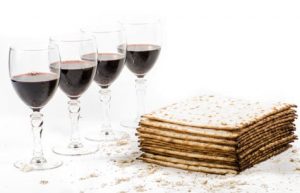
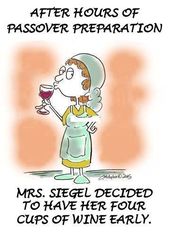 Every year we talk about the elevated stress levels brought on by cooking commercial grade levels of brisket and matzah balls while attempting to eradicate every speck of dirt from the inside of your oven with a toothbrush and how wine selection shouldn’t be an added source of stress. While each and every one of us is already dealing with unimaginable stress levels brought on by the pandemic, I feel more strongly than ever before that wine selection should be as easy, simple and enjoyable as possible. However, as this guide is used by most readers throughout the year as a benchmark for which wines to acquire and all the potential pitfalls remain (and then some), we are going to remain focused on the usual matters the guide is mean to help alleviate while also discussing some of this year’s unfortunately special attributes.
Every year we talk about the elevated stress levels brought on by cooking commercial grade levels of brisket and matzah balls while attempting to eradicate every speck of dirt from the inside of your oven with a toothbrush and how wine selection shouldn’t be an added source of stress. While each and every one of us is already dealing with unimaginable stress levels brought on by the pandemic, I feel more strongly than ever before that wine selection should be as easy, simple and enjoyable as possible. However, as this guide is used by most readers throughout the year as a benchmark for which wines to acquire and all the potential pitfalls remain (and then some), we are going to remain focused on the usual matters the guide is mean to help alleviate while also discussing some of this year’s unfortunately special attributes. In attempt to reduce stress levels in any way I can, I have done the work for you and curated my Annual Pesach Kosher Wine Buying Guide from among the multitude of options being made available. Hopefully the Guide will simplify your wine shopping and allow you to get back more important holiday preparations like being there for your family with love and compassion, helping the many people in dire need of social, emotional and financial support to enjoy a Pesach holiday as it first came to be – as a nation coming together for the first time while developing a more-important-than ever before relationship with hashem (this in addition to the normal stress of preparing Pesach, including those making such preparations for the first time and those contemplating a holiday spent with the fewest number of people ever).
In attempt to reduce stress levels in any way I can, I have done the work for you and curated my Annual Pesach Kosher Wine Buying Guide from among the multitude of options being made available. Hopefully the Guide will simplify your wine shopping and allow you to get back more important holiday preparations like being there for your family with love and compassion, helping the many people in dire need of social, emotional and financial support to enjoy a Pesach holiday as it first came to be – as a nation coming together for the first time while developing a more-important-than ever before relationship with hashem (this in addition to the normal stress of preparing Pesach, including those making such preparations for the first time and those contemplating a holiday spent with the fewest number of people ever). As a transactional lawyer with nearly 20 years of deal-making under my belt, it shouldn’t surprise anyone that a list of this magnitude comes with some fine print and a few important caveats.
As a transactional lawyer with nearly 20 years of deal-making under my belt, it shouldn’t surprise anyone that a list of this magnitude comes with some fine print and a few important caveats.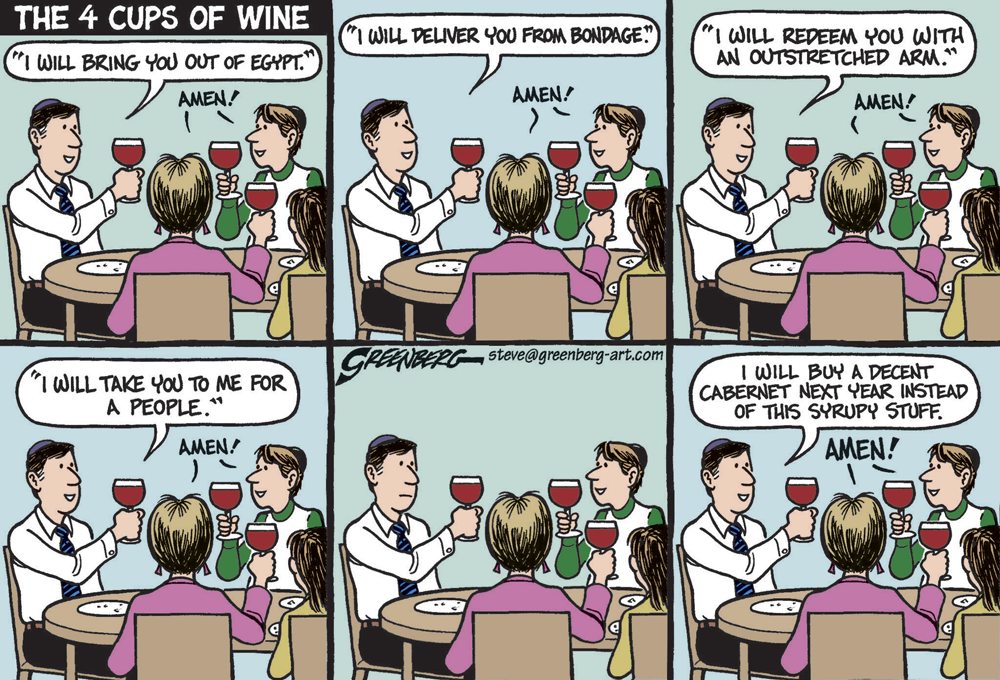 Despite occupying a top spot on any oenophile’s list of favorite customs, the tradition to consume four full cups of wine at the Seder brings a host of potential issues, whose solutions can require a bit of advance thought and planning.
Despite occupying a top spot on any oenophile’s list of favorite customs, the tradition to consume four full cups of wine at the Seder brings a host of potential issues, whose solutions can require a bit of advance thought and planning. Otherwise, I suggest saving the more expensive wines for leisurely drinking during Shulchan Aruch and the plethora of subsequent holiday meals, while finding other worthy options for the four cups. Being a traditionalist, my personal custom is sticking with red wines for all four cups, while using a few basic principles to choose the proper wines. Many folks like to use Rose as a good compromise and, while most versions haven’t yet hit the market (and no 2018 or earlier options should be used), there are a few acceptable options, some of which have been included in the guide.
Otherwise, I suggest saving the more expensive wines for leisurely drinking during Shulchan Aruch and the plethora of subsequent holiday meals, while finding other worthy options for the four cups. Being a traditionalist, my personal custom is sticking with red wines for all four cups, while using a few basic principles to choose the proper wines. Many folks like to use Rose as a good compromise and, while most versions haven’t yet hit the market (and no 2018 or earlier options should be used), there are a few acceptable options, some of which have been included in the guide.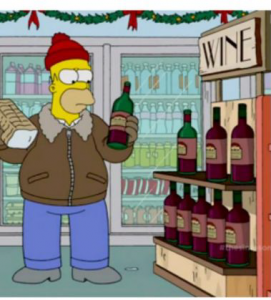 While a number of wines from this tier have moved up one level due to increased prices, t his range includes many good, enjoyable wines. With few exceptions, these wines aren’t complex or cellar worthy. With oak barrels representing a significant percentage of a wine’s cost (actual cost and the time-value of aging), many of these wines have spent little to no time in oak (although oak chips can provide certain benefits without the heavy costs) contributing to their lower prices. Along with focusing on “
While a number of wines from this tier have moved up one level due to increased prices, t his range includes many good, enjoyable wines. With few exceptions, these wines aren’t complex or cellar worthy. With oak barrels representing a significant percentage of a wine’s cost (actual cost and the time-value of aging), many of these wines have spent little to no time in oak (although oak chips can provide certain benefits without the heavy costs) contributing to their lower prices. Along with focusing on “ Moshiach wines are the really special wines that represent top-notch winemaking and plenty of patience on the consumer’s part to allow the wines the additional aging time in the bottle before the wine showcases all it can be (and the perfection intended by the winemaker). Unfortunately as our world continues to devolve into the pursuit for instant gratification, the terrible crime of consuming high-end wines shortly after they are purchased is a crying shame. While certain top tier wines are structured for immediate consumption and long-term aging, a few years of aging nearly always does good things for these wines and is worth the extra time, effort and patience. With the continued global expansion of my
Moshiach wines are the really special wines that represent top-notch winemaking and plenty of patience on the consumer’s part to allow the wines the additional aging time in the bottle before the wine showcases all it can be (and the perfection intended by the winemaker). Unfortunately as our world continues to devolve into the pursuit for instant gratification, the terrible crime of consuming high-end wines shortly after they are purchased is a crying shame. While certain top tier wines are structured for immediate consumption and long-term aging, a few years of aging nearly always does good things for these wines and is worth the extra time, effort and patience. With the continued global expansion of my 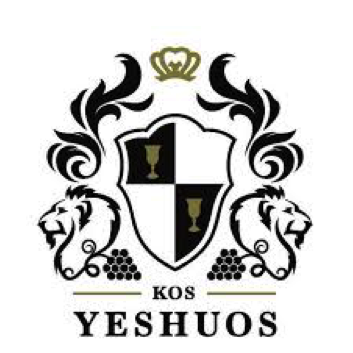
 Kos Yeshuos, The California Kid, 2018: An unoaked blend of Shenandoah Valley Viognier and Carneros Sauvignon Blanc. The varietals were fermented separately before being blended together. With some air the aromatic nose shows gooseberry, hay, freshly mowed grass and some flinty minerals from the Sauvignon Blanc with the Viognier contributing summer stone fruits including white peaches and apricots and creamy citrus. The medium bodied wine has plenty of acidity keeping things lively, along with more fruit, pepper, brown spices and citrus notes. A streak of bitter pith runs through the palate adding complexity and keeping one focused. Well made and delicious, the wine clocks in at 12.5% AbV. Drink now through 2020.
Kos Yeshuos, The California Kid, 2018: An unoaked blend of Shenandoah Valley Viognier and Carneros Sauvignon Blanc. The varietals were fermented separately before being blended together. With some air the aromatic nose shows gooseberry, hay, freshly mowed grass and some flinty minerals from the Sauvignon Blanc with the Viognier contributing summer stone fruits including white peaches and apricots and creamy citrus. The medium bodied wine has plenty of acidity keeping things lively, along with more fruit, pepper, brown spices and citrus notes. A streak of bitter pith runs through the palate adding complexity and keeping one focused. Well made and delicious, the wine clocks in at 12.5% AbV. Drink now through 2020. Kos Yeshuos, Viognier, Shenandoah Valley, 2018: 100% unoaked Viognier sourced from Shenandoah Valley, the wine opens with a serious nose of weighty peach, and apricot with a touch of orange creamsicle and citrus notes. The medium bodied note is slightly less acidic than the California Kid but with enough acid to nicely counter the hefty fruit which is matched with pleasing warm spices. Some flinty minerals and a touch of bitter herbal notes provide nuance and temper the rich fruit. At 12.5% AbV, the wine is less alcoholic than its weight would otherwise indicate and can be enjoyed contemplatively over the course of an evening. Drink now through 2021.
Kos Yeshuos, Viognier, Shenandoah Valley, 2018: 100% unoaked Viognier sourced from Shenandoah Valley, the wine opens with a serious nose of weighty peach, and apricot with a touch of orange creamsicle and citrus notes. The medium bodied note is slightly less acidic than the California Kid but with enough acid to nicely counter the hefty fruit which is matched with pleasing warm spices. Some flinty minerals and a touch of bitter herbal notes provide nuance and temper the rich fruit. At 12.5% AbV, the wine is less alcoholic than its weight would otherwise indicate and can be enjoyed contemplatively over the course of an evening. Drink now through 2021. Kos Yeshuos, Syrah, Shenandoah Valley 2017: After experimenting with Lodi for his first vintage, Josh switched to the Sentinel Oak Vineyard in the Shenandoah Valley as the primary source of his grapes, which remains the case today as well. Showing some bottle variation, two of the five bottles I have tried were slightly frizzante, indicating less than perfect bottling conditions – not an unheard of phenomenon for budding wine producers. At this point, the wine is fully mature and showing beautifully with rich crushed black forest fruits, some tart red notes and a hint of blueberries backed by good acidity, nicely integrating savory tannins and plenty of characteristic Syrah notes including earthy minerals, fresh-cracked black pepper and newly laid asphalt. Hints of dark chocolate, roasted espresso and tobacco leaf are evident on the mid palate and linger on the herbal tinged finish. Drink now.
Kos Yeshuos, Syrah, Shenandoah Valley 2017: After experimenting with Lodi for his first vintage, Josh switched to the Sentinel Oak Vineyard in the Shenandoah Valley as the primary source of his grapes, which remains the case today as well. Showing some bottle variation, two of the five bottles I have tried were slightly frizzante, indicating less than perfect bottling conditions – not an unheard of phenomenon for budding wine producers. At this point, the wine is fully mature and showing beautifully with rich crushed black forest fruits, some tart red notes and a hint of blueberries backed by good acidity, nicely integrating savory tannins and plenty of characteristic Syrah notes including earthy minerals, fresh-cracked black pepper and newly laid asphalt. Hints of dark chocolate, roasted espresso and tobacco leaf are evident on the mid palate and linger on the herbal tinged finish. Drink now.
 Camuna Cellars, Barbera Rose, 2018: After utilizing the acidic Barbera grape so successfully for their inaugural 2017 Rosé, this year’s Rosé is once again 100% barrel-fermented Barbera, albeit from a different vineyard than the 2017 and pressed as whole clusters (the same fruit was utilized for Hajdu’s delicious Rosé). While enjoyable, I found it to be a step-down from last year’s wine showing a little less vibrant and slightly hollow on the mid-palate. That said, the wine is delicious with bright red summer fruits, subtle slate minerals, a little herbal nuance and good acidity backing it up. A little off-kilter on the mid-palate, the wine should be enjoyed well chilled and faithfully fulfills Camuna’s mission for fresh, young and honest wines. Drink now and over the next 12 months or so.
Camuna Cellars, Barbera Rose, 2018: After utilizing the acidic Barbera grape so successfully for their inaugural 2017 Rosé, this year’s Rosé is once again 100% barrel-fermented Barbera, albeit from a different vineyard than the 2017 and pressed as whole clusters (the same fruit was utilized for Hajdu’s delicious Rosé). While enjoyable, I found it to be a step-down from last year’s wine showing a little less vibrant and slightly hollow on the mid-palate. That said, the wine is delicious with bright red summer fruits, subtle slate minerals, a little herbal nuance and good acidity backing it up. A little off-kilter on the mid-palate, the wine should be enjoyed well chilled and faithfully fulfills Camuna’s mission for fresh, young and honest wines. Drink now and over the next 12 months or so. Camuna, High Times, White, 2018: The wine is a blend of Malvasia (54%) and Chardonnay (46%) both sourced from Contra Costa. The wine was co-fermented in neutral oak barrels, which added some enhancing subtle oak nuance. An aromatic nose has green apples, guava, pineapple and other tropical fruit along with floral notes, warm spices some chalky minerals and some nice citrus notes, much of which continues on the round and mouth filling, medium bodied palate that is slightly viscous. Good acidity carries the heft well while the near sweet fruit will be enjoyable by most. Drink now and over the next 9-12 months.
Camuna, High Times, White, 2018: The wine is a blend of Malvasia (54%) and Chardonnay (46%) both sourced from Contra Costa. The wine was co-fermented in neutral oak barrels, which added some enhancing subtle oak nuance. An aromatic nose has green apples, guava, pineapple and other tropical fruit along with floral notes, warm spices some chalky minerals and some nice citrus notes, much of which continues on the round and mouth filling, medium bodied palate that is slightly viscous. Good acidity carries the heft well while the near sweet fruit will be enjoyable by most. Drink now and over the next 9-12 months. Camuna Cellars, Barbera Rose, 2017: An immensely pleasing Rosé, even more as Camuna’s first official released wines, on release the wine showed tart red fruit with some nuanced sweet notes, great citrus and some subtle bitter herbal notes that were augmented by a hint of chalky minerals. Well made with great balance between the lovely tart fruit, sweet notes, minerals and vibrant acidity, the wine bodes well for the future of this talented and passionate young man. Exhibiting plenty of the genre’s food-versatility, the wine was bright, vibrant and fun while showing some delightful funk, earthy and yeasty notes which, at this point are more dominating as the wine has slid past peak and is in Drink Up mode.
Camuna Cellars, Barbera Rose, 2017: An immensely pleasing Rosé, even more as Camuna’s first official released wines, on release the wine showed tart red fruit with some nuanced sweet notes, great citrus and some subtle bitter herbal notes that were augmented by a hint of chalky minerals. Well made with great balance between the lovely tart fruit, sweet notes, minerals and vibrant acidity, the wine bodes well for the future of this talented and passionate young man. Exhibiting plenty of the genre’s food-versatility, the wine was bright, vibrant and fun while showing some delightful funk, earthy and yeasty notes which, at this point are more dominating as the wine has slid past peak and is in Drink Up mode. Camuna Cellars, Carignan, Ancient Vines, Contra Costa, 2017: 100% Carignan sourced from Oakley’s dry-farmed Del Barba Vineyard (the same vineyard as Hajdu’s offering), the over 100-year old vines yield intensely flavored wines with high acidity. Despite utilizing the same grapes, Camuna’s more natural-leaning winemaking philosophy resulted in a much lighter and more approachable wine (while Hajdu’s is darker, brooding, complex and more reminiscent of the other quality Carignan wines we have on the market). Rich notes of plums, tart red cherries, some blueberries and freshly plowed earth are back by lovely acidity and supple tannins and enhanced with subtle notes of flinty minerals and white flowers. Hints of sweet herbs and freshly rolled cigars add both nuance and complexity. Scrumptious with sufficient complexity, the medium bodied wine is loaded with juicy fruit and enjoyable out of the bottle (and isn’t meant for long term aging), and has evolved nicely, showing some added complexity and body at this point along with crème brûlée and some well-worn leather. Drink now through 2021).
Camuna Cellars, Carignan, Ancient Vines, Contra Costa, 2017: 100% Carignan sourced from Oakley’s dry-farmed Del Barba Vineyard (the same vineyard as Hajdu’s offering), the over 100-year old vines yield intensely flavored wines with high acidity. Despite utilizing the same grapes, Camuna’s more natural-leaning winemaking philosophy resulted in a much lighter and more approachable wine (while Hajdu’s is darker, brooding, complex and more reminiscent of the other quality Carignan wines we have on the market). Rich notes of plums, tart red cherries, some blueberries and freshly plowed earth are back by lovely acidity and supple tannins and enhanced with subtle notes of flinty minerals and white flowers. Hints of sweet herbs and freshly rolled cigars add both nuance and complexity. Scrumptious with sufficient complexity, the medium bodied wine is loaded with juicy fruit and enjoyable out of the bottle (and isn’t meant for long term aging), and has evolved nicely, showing some added complexity and body at this point along with crème brûlée and some well-worn leather. Drink now through 2021). Camuna Cellars, High Vibes Nebbiolo, 2017: My least favorite of Camuna’s first offerings, on release the wine showed sweeter fruit that seemed slightly out of balance with the acidity. However with air (and now with some time under its belt), the wine comes together and shows delicious tart red fruits which balance out the sweeter notes, backed by good acidity and elegant well-integrated tannins that provide a good core to the lovely fruit, floral notes, bramble, pepper and warm spices. Really fun and a great everyday wine that can be enjoyed with a wide array of lighter fare, while also providing satisfying pleasure on its own. Drink now through 2020, but make sure to decant or give the wine at least 20 minutes to open in your glass.
Camuna Cellars, High Vibes Nebbiolo, 2017: My least favorite of Camuna’s first offerings, on release the wine showed sweeter fruit that seemed slightly out of balance with the acidity. However with air (and now with some time under its belt), the wine comes together and shows delicious tart red fruits which balance out the sweeter notes, backed by good acidity and elegant well-integrated tannins that provide a good core to the lovely fruit, floral notes, bramble, pepper and warm spices. Really fun and a great everyday wine that can be enjoyed with a wide array of lighter fare, while also providing satisfying pleasure on its own. Drink now through 2020, but make sure to decant or give the wine at least 20 minutes to open in your glass.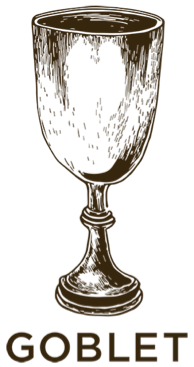
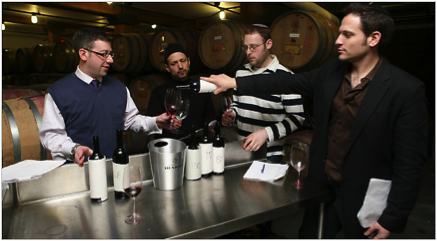 years. Having been acquainted with a number of City Winery’s initial investors (most of whom made private barrels of kosher wine as part of their investment), I have been acquainted with City Winery and its operations since the very beginning. Early on, we conducted the blind tastings for the Jewish Week’s annual Kosher Wine Guide at the winery and I spent a fair amount of time with the winemaking team (
years. Having been acquainted with a number of City Winery’s initial investors (most of whom made private barrels of kosher wine as part of their investment), I have been acquainted with City Winery and its operations since the very beginning. Early on, we conducted the blind tastings for the Jewish Week’s annual Kosher Wine Guide at the winery and I spent a fair amount of time with the winemaking team ( Monsey, wine was always part of the family’s Shabbat celebrations but it wasn’t until he went away to England to learn in a Gateshead yeshiva that he was bitten by the winemaking bug (although he’s mentioned that as a kid he used to try and turn table grapes into wine with little success and pointed to a tasting in Israel of the Yarden Gewurztraminer from the Golan Heights as another turning point in his interest in wines and winemaking). One of the rabbis in a neighboring yeshiva needed some assistance in producing his homemade wine and after volunteering to help out, Yanky found himself mesmerized by the entire process. Returning home, Yanky was determined to pursue his newfound passion and interned with a number of local wineries. It was in conjunction with an internship at New York’s North Fork Palmer Vineyards that he made his first (tiny) batch of wine for the 2005 vintage, using Merlot grapes “earned” from his internship work. Energized by the initial experience, Yanky continue to pursue his home-winemaking hobby and his search for wine barrels introduced him to City Winery through Ilan, which ultimately provided him with his winemaking day job (and the place where he continued his winemaking education under David Lecomte) as Ilan told him about the vacancy he ended up filling.
Monsey, wine was always part of the family’s Shabbat celebrations but it wasn’t until he went away to England to learn in a Gateshead yeshiva that he was bitten by the winemaking bug (although he’s mentioned that as a kid he used to try and turn table grapes into wine with little success and pointed to a tasting in Israel of the Yarden Gewurztraminer from the Golan Heights as another turning point in his interest in wines and winemaking). One of the rabbis in a neighboring yeshiva needed some assistance in producing his homemade wine and after volunteering to help out, Yanky found himself mesmerized by the entire process. Returning home, Yanky was determined to pursue his newfound passion and interned with a number of local wineries. It was in conjunction with an internship at New York’s North Fork Palmer Vineyards that he made his first (tiny) batch of wine for the 2005 vintage, using Merlot grapes “earned” from his internship work. Energized by the initial experience, Yanky continue to pursue his home-winemaking hobby and his search for wine barrels introduced him to City Winery through Ilan, which ultimately provided him with his winemaking day job (and the place where he continued his winemaking education under David Lecomte) as Ilan told him about the vacancy he ended up filling.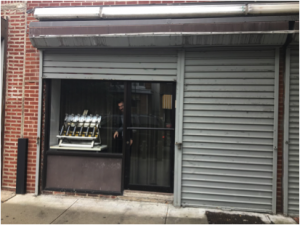 Having continued to make his own wine continuously, in 2013 Yanky founded Goblet as his own label and, taking a page from City Winery’s pioneering urban winery playbook, opened up shop in a Brooklyn storefront in 2014. Leveraging his connections with wineries around the world (primarily (but not only) through his work at City winery), Yanky sources his grapes globally, with the diverse range of grape-growing regions including Mendocino and Napa Valley (California), Finger Lakes (New York), Mendoza (Argentina) and Chile.
Having continued to make his own wine continuously, in 2013 Yanky founded Goblet as his own label and, taking a page from City Winery’s pioneering urban winery playbook, opened up shop in a Brooklyn storefront in 2014. Leveraging his connections with wineries around the world (primarily (but not only) through his work at City winery), Yanky sources his grapes globally, with the diverse range of grape-growing regions including Mendocino and Napa Valley (California), Finger Lakes (New York), Mendoza (Argentina) and Chile.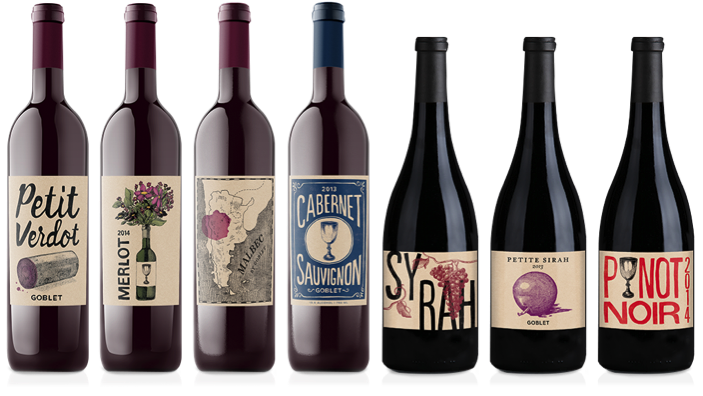 While still early in the process of determining the winery’s path forward, Yanky considers his “regular” offerings (i.e. those expected to be produced annually on a regular basis) to be varietal Merlot, Syrah, Pinot Noir, Malbec, Cabernet Sauvignon and Riesling on a regular basis with additional wines in the experimental phase (whose future will be determined based on the resulting wine’s quality and consumer reception) including Petit Verdot, Petit Sirah, Cabernet Franc, Carménère, Grenache and a sparkling wine made in the méthode champenoise. The bright and bold labels designed by Yanky match the wine’s style, with plenty of rich fruit and bold flavors. The wines aren’t divided into series and each wine is a stand-alone product (subject to the regular versus occasional concept mentioned above) with the reds all being priced basically the same and the one white (Riesling) priced lower.
While still early in the process of determining the winery’s path forward, Yanky considers his “regular” offerings (i.e. those expected to be produced annually on a regular basis) to be varietal Merlot, Syrah, Pinot Noir, Malbec, Cabernet Sauvignon and Riesling on a regular basis with additional wines in the experimental phase (whose future will be determined based on the resulting wine’s quality and consumer reception) including Petit Verdot, Petit Sirah, Cabernet Franc, Carménère, Grenache and a sparkling wine made in the méthode champenoise. The bright and bold labels designed by Yanky match the wine’s style, with plenty of rich fruit and bold flavors. The wines aren’t divided into series and each wine is a stand-alone product (subject to the regular versus occasional concept mentioned above) with the reds all being priced basically the same and the one white (Riesling) priced lower.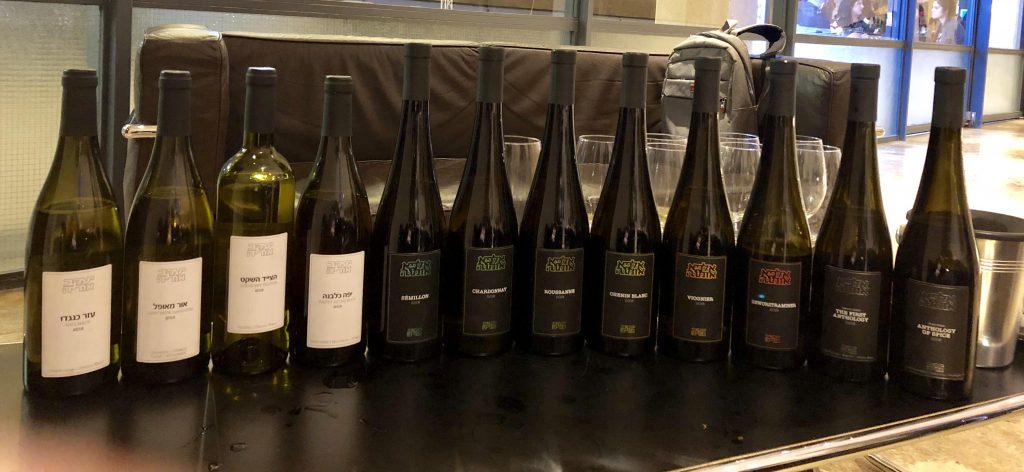 #375 – May 3, 2019
#375 – May 3, 2019
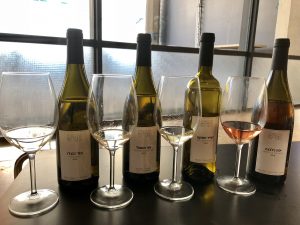 Interestingly, those not yet into wines can find orange-styled wines enjoyable as they are neither heavily tannic like many newly-released red wines or overly astringent like so many of today’s white wines while providing subdued honeyed fruit notes with sour undertones. From Yaacov’s perspective, the wines are there to stimulate thought, conversation and wonderment while also providing pleasure. For the most part, the wines range between 11% – 13% AbV, a rarity for Israeli wines and nearly all of them benefit from time and quiet contemplation. This doesn’t mean they don’t provide immense pleasure as enjoyable wines, but rather they are intellectual wines with a whole additional side of contemplation waiting to be discovered. Either way, all the wines are highly recommended and, like most other wines, will be much more enjoyable with a few friends while tasting a number of them side by side and comparing notes.
Interestingly, those not yet into wines can find orange-styled wines enjoyable as they are neither heavily tannic like many newly-released red wines or overly astringent like so many of today’s white wines while providing subdued honeyed fruit notes with sour undertones. From Yaacov’s perspective, the wines are there to stimulate thought, conversation and wonderment while also providing pleasure. For the most part, the wines range between 11% – 13% AbV, a rarity for Israeli wines and nearly all of them benefit from time and quiet contemplation. This doesn’t mean they don’t provide immense pleasure as enjoyable wines, but rather they are intellectual wines with a whole additional side of contemplation waiting to be discovered. Either way, all the wines are highly recommended and, like most other wines, will be much more enjoyable with a few friends while tasting a number of them side by side and comparing notes.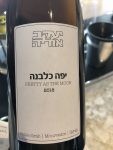 Yaacov Oryah, Pretty as the Moon (Yafa K’Levana), Rosé, 2018: Have no fear – being one of the least likely winemakers to follow any sort of trend, Yaacov hasn’t succumbed to the prevailing winds of rose – the wine is a mistake of sorts, as ever-so-subtlety indicated by the play on words in the wine’s name. A blend of Petite Sirah (53%), Mourvèdre (29%) and Syrah (18%) that was intended to be a blanc de noir but turned out as a rose de noir instead. Levana is Hebrew for the moon and the female form of the color white, reflecting the fact that the wine is a great as the white wine it was intended to be. The wine has a subtle nose of dark red fruit including tart raspberries and pomegranate along with some funky minerals, slate and heather notes. The medium bodied palate is loaded with bright acidity that is nicely balanced with the slightly hefty fruit, more minerals and a streak of slightly bitter salinity that carries through the lingering finish. A delicious and easy to drink wine with enough complexity to please the more discerning wine lovers as well. 13% AbV. Drink now and over the next 9-15 months or so.
Yaacov Oryah, Pretty as the Moon (Yafa K’Levana), Rosé, 2018: Have no fear – being one of the least likely winemakers to follow any sort of trend, Yaacov hasn’t succumbed to the prevailing winds of rose – the wine is a mistake of sorts, as ever-so-subtlety indicated by the play on words in the wine’s name. A blend of Petite Sirah (53%), Mourvèdre (29%) and Syrah (18%) that was intended to be a blanc de noir but turned out as a rose de noir instead. Levana is Hebrew for the moon and the female form of the color white, reflecting the fact that the wine is a great as the white wine it was intended to be. The wine has a subtle nose of dark red fruit including tart raspberries and pomegranate along with some funky minerals, slate and heather notes. The medium bodied palate is loaded with bright acidity that is nicely balanced with the slightly hefty fruit, more minerals and a streak of slightly bitter salinity that carries through the lingering finish. A delicious and easy to drink wine with enough complexity to please the more discerning wine lovers as well. 13% AbV. Drink now and over the next 9-15 months or so.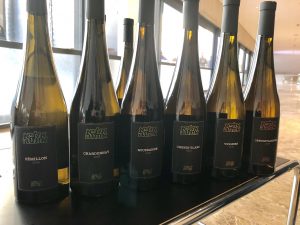
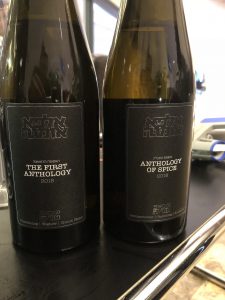 Yaacov Oryah, Alpha Omega, The First Anthology (HaAsufa HaRishona), 2018: As alluded to by the name, the wine pays homage to Yaacov’s first Orange wine – the 2007 Asif mentioned above (Asufa and Asif share the same root in Hebrew). Utilizing the same varietals as that initial blend – Chardonnay, Viognier and Chenin Blanc (albeit in different percentages – 40%, 40% and 20% respectively), the components are comprised of the varietal Alpha Omega Orange-styled wines listed above. A subdued nose has plenty of yellow sweet apple and pears along with warm spice. The medium bodied palate has plenty of sweet fruit, baked apple pie, flinty minerals on a background of cloves and more minerals and backed by good acidity, elegant subtle tannins and sweet herbs. powerful and elegant, the wine is lithe and precise with citrus and earthy notes lingering long. Drink now through 2023.
Yaacov Oryah, Alpha Omega, The First Anthology (HaAsufa HaRishona), 2018: As alluded to by the name, the wine pays homage to Yaacov’s first Orange wine – the 2007 Asif mentioned above (Asufa and Asif share the same root in Hebrew). Utilizing the same varietals as that initial blend – Chardonnay, Viognier and Chenin Blanc (albeit in different percentages – 40%, 40% and 20% respectively), the components are comprised of the varietal Alpha Omega Orange-styled wines listed above. A subdued nose has plenty of yellow sweet apple and pears along with warm spice. The medium bodied palate has plenty of sweet fruit, baked apple pie, flinty minerals on a background of cloves and more minerals and backed by good acidity, elegant subtle tannins and sweet herbs. powerful and elegant, the wine is lithe and precise with citrus and earthy notes lingering long. Drink now through 2023.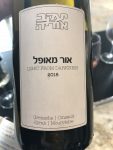 Ya’acov Oryah, Light from Darkness (Or M’Ofel), 2018: A blend of 33% Grenache, 31% Cinsault, 24% Syrah, and 12% Mourvèdre, the wine’s name basically means blanc de noir (Light (wine) from Darkness (grapes)). The wine was made with no skin contact or malolactic fermentation, which allowed for a fresh and vibrant wine. Harvested early, the wine clocks in at 11.5% AbV. Plenty of red fruit and floral notes on both the nose and palate along with rich minerals, near-sweet tropical fruit with plenty of lip-smacking acidity. With air, the wine opens up to reveal layers of complexity along with freshly dried hay and herbal notes. Drink now through 2021.
Ya’acov Oryah, Light from Darkness (Or M’Ofel), 2018: A blend of 33% Grenache, 31% Cinsault, 24% Syrah, and 12% Mourvèdre, the wine’s name basically means blanc de noir (Light (wine) from Darkness (grapes)). The wine was made with no skin contact or malolactic fermentation, which allowed for a fresh and vibrant wine. Harvested early, the wine clocks in at 11.5% AbV. Plenty of red fruit and floral notes on both the nose and palate along with rich minerals, near-sweet tropical fruit with plenty of lip-smacking acidity. With air, the wine opens up to reveal layers of complexity along with freshly dried hay and herbal notes. Drink now through 2021.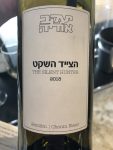 Ya’acov Oryah, Silent Hunter (HaTzayad HaShaket), 2018: The wine’s name alludes to Australia’s Hunter Valley – home to some of the longest-lasting (and most interesting) expressions of Semillon out there, with the silence referring to the Chenin’s dominance in the blend (despite the lower percentage). A blend of Semillon (60%) and Chenin Blanc (40%), the Chenin adds significant heft (and some floral perfume) without taking away from the heather and mineral notes the Semillon brings to the table. The expressive nose is clean, precise and elegant with near-sweet fruit balanced with saline minerals, gun smoke, flint and creamy citrus notes. The medium bodied palate is loaded with acid that provides perfect contra to the rich fruit, slate minerals and lip-smacking citrus that evolves throughout the long mid-palate into the long lingering finish. I enjoyed this wine’s evolution over seven hours and it wasn’t close to being done. Highly enjoyable now but with so much hidden potential ahead of it, it’s almost criminal to open it now, but if you must make sure it gets at least two hours in the decanter. Better to wait 12-18 months before enjoying through 2025, maybe longer. 11.5% AbV.
Ya’acov Oryah, Silent Hunter (HaTzayad HaShaket), 2018: The wine’s name alludes to Australia’s Hunter Valley – home to some of the longest-lasting (and most interesting) expressions of Semillon out there, with the silence referring to the Chenin’s dominance in the blend (despite the lower percentage). A blend of Semillon (60%) and Chenin Blanc (40%), the Chenin adds significant heft (and some floral perfume) without taking away from the heather and mineral notes the Semillon brings to the table. The expressive nose is clean, precise and elegant with near-sweet fruit balanced with saline minerals, gun smoke, flint and creamy citrus notes. The medium bodied palate is loaded with acid that provides perfect contra to the rich fruit, slate minerals and lip-smacking citrus that evolves throughout the long mid-palate into the long lingering finish. I enjoyed this wine’s evolution over seven hours and it wasn’t close to being done. Highly enjoyable now but with so much hidden potential ahead of it, it’s almost criminal to open it now, but if you must make sure it gets at least two hours in the decanter. Better to wait 12-18 months before enjoying through 2025, maybe longer. 11.5% AbV.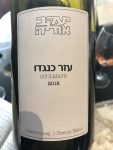 Ya’acov Oryah, Soulmate (Ezer K’Negdo), 2018: the wine’s name has a dual meaning, reflecting how the perfect mate creates a sum greater than its part but also pays homage to Yaacov’s wife Patricia who convinced him to use the varietal in the blend, which resulted in this delightfully delicious wine. A blend of Chardonnay (55%) and Chenin Blanc (45%), the Chardonnay is sourced from a plot shared with Domaine du Castel and Vitkin. Great viscosity, medium bodied with hints of tropical fruit with plenty of clean minerals and warm spices galore. Fresh and vibrant with clean lines and hefty fruit from the Chardonnay. Red grapefruit, Mayer lemon and plenty of floral notes provide the over-arching notes with the minerals and acid providing the underlying background that carries the wine through. Lithe and delicious, the wine is highly enjoyable. 12.5% AbV. Drink now through 2021.
Ya’acov Oryah, Soulmate (Ezer K’Negdo), 2018: the wine’s name has a dual meaning, reflecting how the perfect mate creates a sum greater than its part but also pays homage to Yaacov’s wife Patricia who convinced him to use the varietal in the blend, which resulted in this delightfully delicious wine. A blend of Chardonnay (55%) and Chenin Blanc (45%), the Chardonnay is sourced from a plot shared with Domaine du Castel and Vitkin. Great viscosity, medium bodied with hints of tropical fruit with plenty of clean minerals and warm spices galore. Fresh and vibrant with clean lines and hefty fruit from the Chardonnay. Red grapefruit, Mayer lemon and plenty of floral notes provide the over-arching notes with the minerals and acid providing the underlying background that carries the wine through. Lithe and delicious, the wine is highly enjoyable. 12.5% AbV. Drink now through 2021. Yaacov Oryah, Alpha Omega, Chenin Blanc, 2017: The wine opens with a near-sweet and expressive nose of heather honeysuckle dominating but also sweet orange citrus notes, pineapple and some yellow pears. The rich nose leads your expectations toward a full and juicy near-sweet wine before the medium bodied and slightly viscous wine hits your palate. There is a complete dissonance between what the nose led you to expect and the lean, subtle and complex palate your mouth experiences – crazy experience. That said, ignoring the false expectations from the nose, the wine is round and mouth-filling with great balancing acidity and subtle fruit augmented by rich flint minerals, saline tannin, roasted nuts, black tea and bitter orange pith. Medium to full bodied with a nice heft and nuanced complexity on clean lines and superb balance. Varietal characteristics of the Chenin are more evident after 30 minutes of air and are pronounced on the mid palate and lingering finish. 11.5% AbV, drink now through 2023.
Yaacov Oryah, Alpha Omega, Chenin Blanc, 2017: The wine opens with a near-sweet and expressive nose of heather honeysuckle dominating but also sweet orange citrus notes, pineapple and some yellow pears. The rich nose leads your expectations toward a full and juicy near-sweet wine before the medium bodied and slightly viscous wine hits your palate. There is a complete dissonance between what the nose led you to expect and the lean, subtle and complex palate your mouth experiences – crazy experience. That said, ignoring the false expectations from the nose, the wine is round and mouth-filling with great balancing acidity and subtle fruit augmented by rich flint minerals, saline tannin, roasted nuts, black tea and bitter orange pith. Medium to full bodied with a nice heft and nuanced complexity on clean lines and superb balance. Varietal characteristics of the Chenin are more evident after 30 minutes of air and are pronounced on the mid palate and lingering finish. 11.5% AbV, drink now through 2023. Ya’acov Oryah, Light from Darkness (Or M’Ofel), 2017: In addition to the Grenache Noir, Cinsault, Syrah, and Mourvèdre included in the 2018 blend above, this wine included Tempranillo as well. The wine’s name is basically Hebrew for blanc de noir (Light (wine) from Darkness (grapes)). More fruit forward and approachable than the 2016 below, the wine has lovely notes of tropical fruit, melon and citrus with less red fruit. A highly aromatic nose and medium bodied palate are both loaded to bear with citrus galore, slate minerals and some stone summer fruits all backed with judicious acid impeccably balanced with the rich and slightly viscous fruit and hefty dose of minerals. 11%AbV. Drink now through 2022.
Ya’acov Oryah, Light from Darkness (Or M’Ofel), 2017: In addition to the Grenache Noir, Cinsault, Syrah, and Mourvèdre included in the 2018 blend above, this wine included Tempranillo as well. The wine’s name is basically Hebrew for blanc de noir (Light (wine) from Darkness (grapes)). More fruit forward and approachable than the 2016 below, the wine has lovely notes of tropical fruit, melon and citrus with less red fruit. A highly aromatic nose and medium bodied palate are both loaded to bear with citrus galore, slate minerals and some stone summer fruits all backed with judicious acid impeccably balanced with the rich and slightly viscous fruit and hefty dose of minerals. 11%AbV. Drink now through 2022. Yaacov Oryah, Saignée d’Orange, 2017: Bled from the Alpha Omega Chenin Blanc above, the wine is 100% Chenin Blanc. When bleeding the juice of red grapes, the result is a Rose while bleeding the juice of a white grape yielded a wine that tastes like an orange wine while presenting like a white one. Pronounced funk and the subtle viscosity of Yaacov’s orange wines, the wine showcases floral and mineral notes with the fruit subdued in the background. Nicely balancing acidity and spicy ginger notes round out the wine and give it some welcome complexity. 11.5% AbV. Drink now.
Yaacov Oryah, Saignée d’Orange, 2017: Bled from the Alpha Omega Chenin Blanc above, the wine is 100% Chenin Blanc. When bleeding the juice of red grapes, the result is a Rose while bleeding the juice of a white grape yielded a wine that tastes like an orange wine while presenting like a white one. Pronounced funk and the subtle viscosity of Yaacov’s orange wines, the wine showcases floral and mineral notes with the fruit subdued in the background. Nicely balancing acidity and spicy ginger notes round out the wine and give it some welcome complexity. 11.5% AbV. Drink now.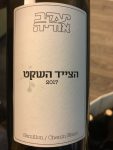 Ya’acov Oryah, Silent Hunter (HaTzayad HaShaket), 2017: The wine is an unoaked blend of 60% Sémillon and 40% Chenin Blanc (the two varietals that Ya’acov does best with) and the name is a nod to Australia’s Hunter Valley whose Sémillon wines have extensive aging abilities (Yaacov’s 2009 “Valley of the Hunters” was made in that style, as is his not-yet-released 2017 version). The wine was allowed to go through full malolactic fermentation that yielded a rich and unctuous wine, with plenty of delicious fruit kept in check by great tempering acidity. Loads of flinty minerals are accompanied by subtle tropical fruit, dried summer stone fruit, heather and honeysuckle, along with some spice, pear and ginger. Lemon zest and more citrus are enhance by pleasing notes of white flowers, lemongrass, all well-balanced by bracing acidity that ensures this rich and lovely wine stays crisp, vibrant and refreshing all the way through the medium bodied palate to the long lingering and citrus-laden finish. Really a complex wine that is worth your time and patience to open up in the glass. Part of the wine was also made into a sparkling wine, so stay tuned for some exciting sparklers coming from Ya’acov in a few years. At 11% AbV, the wine is great all day, every day and while it can be enjoyed mindlessly, denying the wine some thoughtful contemplation would be missing out on a huge part of the experience. While enjoyable now, the wine has tons of evolution ahead of it, so I’d suggest cellaring a few of your bottles to enjoy over the years through 2028, likely longer.
Ya’acov Oryah, Silent Hunter (HaTzayad HaShaket), 2017: The wine is an unoaked blend of 60% Sémillon and 40% Chenin Blanc (the two varietals that Ya’acov does best with) and the name is a nod to Australia’s Hunter Valley whose Sémillon wines have extensive aging abilities (Yaacov’s 2009 “Valley of the Hunters” was made in that style, as is his not-yet-released 2017 version). The wine was allowed to go through full malolactic fermentation that yielded a rich and unctuous wine, with plenty of delicious fruit kept in check by great tempering acidity. Loads of flinty minerals are accompanied by subtle tropical fruit, dried summer stone fruit, heather and honeysuckle, along with some spice, pear and ginger. Lemon zest and more citrus are enhance by pleasing notes of white flowers, lemongrass, all well-balanced by bracing acidity that ensures this rich and lovely wine stays crisp, vibrant and refreshing all the way through the medium bodied palate to the long lingering and citrus-laden finish. Really a complex wine that is worth your time and patience to open up in the glass. Part of the wine was also made into a sparkling wine, so stay tuned for some exciting sparklers coming from Ya’acov in a few years. At 11% AbV, the wine is great all day, every day and while it can be enjoyed mindlessly, denying the wine some thoughtful contemplation would be missing out on a huge part of the experience. While enjoyable now, the wine has tons of evolution ahead of it, so I’d suggest cellaring a few of your bottles to enjoy over the years through 2028, likely longer. Yaacov Oryah, SOB, 2017 [Advance Tasting]: The wine is a private bottling and Yaacov kept one barrel for himself. An eccentric blend of Grenache (22%), Petite Sirah (21%), Carignan (20%), Pinot Noir (19%) and Syrah (18%), each component was added for a specific purpose. The wine is obviously super young and needs time to come together. At this point there is plenty of ripe red fruit on both the nose and palate alongside toasty oak (the wine was aged in one new 300 liter barrel and two one-year old barrels) and nice earthy minerals. The medium bodied palate is backed by gripping elegant tannins, with good acidity keeping things lively. Fruit forward and fun at this point, I’d give the wine at least a year before opening, after which is should cellar through 2022, likely longer (given the uniqueness of the blend, I am erring on the side of caution here).
Yaacov Oryah, SOB, 2017 [Advance Tasting]: The wine is a private bottling and Yaacov kept one barrel for himself. An eccentric blend of Grenache (22%), Petite Sirah (21%), Carignan (20%), Pinot Noir (19%) and Syrah (18%), each component was added for a specific purpose. The wine is obviously super young and needs time to come together. At this point there is plenty of ripe red fruit on both the nose and palate alongside toasty oak (the wine was aged in one new 300 liter barrel and two one-year old barrels) and nice earthy minerals. The medium bodied palate is backed by gripping elegant tannins, with good acidity keeping things lively. Fruit forward and fun at this point, I’d give the wine at least a year before opening, after which is should cellar through 2022, likely longer (given the uniqueness of the blend, I am erring on the side of caution here). Yaacov Oryah, Alpha Omega, Jemma, Brut, 2016: Made exclusively for the Tel-Aviv restaurant Brut (with whom Yaacov has a close relationship) and named for the eatery’s co-founder – Jemma Naveh. An Orange-styled wine made from 100% Semillon, the wine needs hours and hours of air and is enjoyable every step of the way while being educational as well. With a plush medium to full-bodied palate, the wine showcases loads of warm spices, roasted nuts, fresh-turned earth and earthy mineral notes under plenty of funky orange notes, wild mushrooms, smoke, candied almonds, smoky wood, and dried tropical fruit. Spice and dried nuts linger long with brilliant acidity keeping things interesting. Really interesting and enjoyable wine that will pair well with a near-endless array of foods. Drink now through 2021.
Yaacov Oryah, Alpha Omega, Jemma, Brut, 2016: Made exclusively for the Tel-Aviv restaurant Brut (with whom Yaacov has a close relationship) and named for the eatery’s co-founder – Jemma Naveh. An Orange-styled wine made from 100% Semillon, the wine needs hours and hours of air and is enjoyable every step of the way while being educational as well. With a plush medium to full-bodied palate, the wine showcases loads of warm spices, roasted nuts, fresh-turned earth and earthy mineral notes under plenty of funky orange notes, wild mushrooms, smoke, candied almonds, smoky wood, and dried tropical fruit. Spice and dried nuts linger long with brilliant acidity keeping things interesting. Really interesting and enjoyable wine that will pair well with a near-endless array of foods. Drink now through 2021.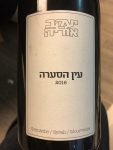 Yaacov Oryah, Eye of the Storm (Ein HaSa’ara), 2016: Yaacov’s GSM has become a regular part of his portfolio and the 2016 is more reminiscent of his delightful 2016 than the 2015 version. The wine spent 12 months in oak given it some pleasing smoky notes in addition to the rich red fruit (which was slightly ripe for me without being sweet), backed by gripping tannins that need time to integrate and good acidity keeping the fruit well balanced while the oak remains in the background. Savory notes of roasted meat, asphalt and leather are joined by earthy minerals, freshly cracked black pepper, earthy minerals and some herbal notes all blend together and yield a food-friendly wine with more mainstream appeal that many of Yaacov’s other wines. 13.5% AbV. Drink now through 2023.
Yaacov Oryah, Eye of the Storm (Ein HaSa’ara), 2016: Yaacov’s GSM has become a regular part of his portfolio and the 2016 is more reminiscent of his delightful 2016 than the 2015 version. The wine spent 12 months in oak given it some pleasing smoky notes in addition to the rich red fruit (which was slightly ripe for me without being sweet), backed by gripping tannins that need time to integrate and good acidity keeping the fruit well balanced while the oak remains in the background. Savory notes of roasted meat, asphalt and leather are joined by earthy minerals, freshly cracked black pepper, earthy minerals and some herbal notes all blend together and yield a food-friendly wine with more mainstream appeal that many of Yaacov’s other wines. 13.5% AbV. Drink now through 2023. Ya’acov Oryah, Light from Darkness (Or M’Ofel), 2016: Maintaining a reputation for quality experimentation, the wine’s name reflects the creating of a white wine from three Rhône Valley red varietals (Grenache, Cinsault and Mourvèdre), accomplished by not allowing the juice any skin contact whatsoever (all grape juices are clear – the color comes from skin, stems and other parts). As a wine geek I am always excited to taste wines made in a new or interesting manner, many of which aren’t the most delicious of options and I was happy to find this wine didn’t fit into that category – it’s really a yummy wine (in addition to the coolness of having typical red wine notes in a white wine). The nose is redolent with mulberry, raspberry, red cherry along with white flowers, red grapefruit and lime with a hint of bitter green and flinty minerals. The medium to full bodied palate is more robust than you’d expect with great acidity balancing out the rich and deep fruits with plentiful lip-smacking citrus and savory minerals on the mid palate leading into the lingering finish where some bitter grapefruit pith leaves a tantalizing reminder of the delicious treat. 11.5% AbV. Enjoyable now through the middle of 2019.
Ya’acov Oryah, Light from Darkness (Or M’Ofel), 2016: Maintaining a reputation for quality experimentation, the wine’s name reflects the creating of a white wine from three Rhône Valley red varietals (Grenache, Cinsault and Mourvèdre), accomplished by not allowing the juice any skin contact whatsoever (all grape juices are clear – the color comes from skin, stems and other parts). As a wine geek I am always excited to taste wines made in a new or interesting manner, many of which aren’t the most delicious of options and I was happy to find this wine didn’t fit into that category – it’s really a yummy wine (in addition to the coolness of having typical red wine notes in a white wine). The nose is redolent with mulberry, raspberry, red cherry along with white flowers, red grapefruit and lime with a hint of bitter green and flinty minerals. The medium to full bodied palate is more robust than you’d expect with great acidity balancing out the rich and deep fruits with plentiful lip-smacking citrus and savory minerals on the mid palate leading into the lingering finish where some bitter grapefruit pith leaves a tantalizing reminder of the delicious treat. 11.5% AbV. Enjoyable now through the middle of 2019. Yaacov Oryah, Alpha Omega, 2014: A limited edition (less than 300 bottles) blend of Roussanne, Viognier and Sémillon that was prepared like an Orange Wine and was allowed to
Yaacov Oryah, Alpha Omega, 2014: A limited edition (less than 300 bottles) blend of Roussanne, Viognier and Sémillon that was prepared like an Orange Wine and was allowed to  macerate on its skins for over two months (73 days) yielding a rich, bold and funky wine that I found to be fascinating but won’t be to everyone’s taste. With his first attempt at Orange wine spending just two weeks on the skins, the Alpha Omega represents a quantum leap forward in this regard. Using the biblical “HaKol Kol Yaacov VeHaYadayim Yedei Eisav” (“the voice is the voice of Yaacov, yet the hands are the hands of Esauv”) wouldn’t be inappropriate in this case. A rich aromatic nose is redolent with rich orange and lemon, honeysuckle, candied citrus peel, scented candles, a whiff of oily petrol, jasmine, lavender and crazily enough – subtle notes of smoked meat. The medium bodied and layered palate has a slightly oily feel to it that is backed up with plenty of acidity that also keeps the rich fruit in check and a completely unnerving tannic structure that can provide whiplash if you aren’t expecting it. Ever more than the 2016, the dissonance between nose and palate can be unnerving. With gun smoke, melon, tart green apple and more juicy citrus alongside oxidized notes, the wine toys with your senses and reveals layers and layers of notes as time passes by. A long and lingering slightly tart and savory finish with an overlay of orange blossom rounds out this incredibly different (and delicious) wine. Made in Yaacov’s house without any formal hashgacha, the wine doesn’t carry any kosher symbols but like his prior wines, he vouches for it, which was enough for me. 13% AbV. Definitely a must try and still needs 1-2 hours in the decanter before it reveals all it has to offer, the wine should continue to evolve through 2021, likely longer.
macerate on its skins for over two months (73 days) yielding a rich, bold and funky wine that I found to be fascinating but won’t be to everyone’s taste. With his first attempt at Orange wine spending just two weeks on the skins, the Alpha Omega represents a quantum leap forward in this regard. Using the biblical “HaKol Kol Yaacov VeHaYadayim Yedei Eisav” (“the voice is the voice of Yaacov, yet the hands are the hands of Esauv”) wouldn’t be inappropriate in this case. A rich aromatic nose is redolent with rich orange and lemon, honeysuckle, candied citrus peel, scented candles, a whiff of oily petrol, jasmine, lavender and crazily enough – subtle notes of smoked meat. The medium bodied and layered palate has a slightly oily feel to it that is backed up with plenty of acidity that also keeps the rich fruit in check and a completely unnerving tannic structure that can provide whiplash if you aren’t expecting it. Ever more than the 2016, the dissonance between nose and palate can be unnerving. With gun smoke, melon, tart green apple and more juicy citrus alongside oxidized notes, the wine toys with your senses and reveals layers and layers of notes as time passes by. A long and lingering slightly tart and savory finish with an overlay of orange blossom rounds out this incredibly different (and delicious) wine. Made in Yaacov’s house without any formal hashgacha, the wine doesn’t carry any kosher symbols but like his prior wines, he vouches for it, which was enough for me. 13% AbV. Definitely a must try and still needs 1-2 hours in the decanter before it reveals all it has to offer, the wine should continue to evolve through 2021, likely longer.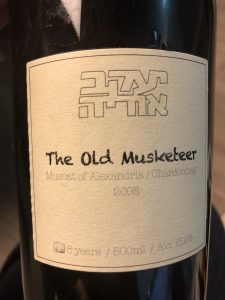 Yaacov Oryah, Old Musketeer, 2008 (8 Year): A limited edition of 1,000 bottles, the wine is late harvested Muscat of Alexandria spent seven years aging in used oak barrels before being blended with 6% 2015 Chardonnay which provided acidity to back up the rich sweetness and balanced out the oxidized notes that give the wine its complexity and testify to its potential longevity. The long-term aging is intended to allow the wine to slowly mature and oxidize providing it with complex flavors while also protecting it from future deterioration due to oxidization, thus prolonging its ageability. Additional wine remains in barrels and Yaacov intends to bottle a barrel or so every year or two (includung the incredible 10-Year option reviewed below). A lively and aromatic nose and a full bodied and rich palate back by good acidity are both redolent of honeysuckle, blooming white flowers, crème brûlée, toasted hazelnuts, white chocolate, candied lemons, a hint of white pepper and expressive notes of tropical fruit all balanced by warm spices and spicy oak and a long lingering sweet finish that is enhanced by great spices and more developing complexity. 15.9% AbV. Drink now through 2035, likely longer
Yaacov Oryah, Old Musketeer, 2008 (8 Year): A limited edition of 1,000 bottles, the wine is late harvested Muscat of Alexandria spent seven years aging in used oak barrels before being blended with 6% 2015 Chardonnay which provided acidity to back up the rich sweetness and balanced out the oxidized notes that give the wine its complexity and testify to its potential longevity. The long-term aging is intended to allow the wine to slowly mature and oxidize providing it with complex flavors while also protecting it from future deterioration due to oxidization, thus prolonging its ageability. Additional wine remains in barrels and Yaacov intends to bottle a barrel or so every year or two (includung the incredible 10-Year option reviewed below). A lively and aromatic nose and a full bodied and rich palate back by good acidity are both redolent of honeysuckle, blooming white flowers, crème brûlée, toasted hazelnuts, white chocolate, candied lemons, a hint of white pepper and expressive notes of tropical fruit all balanced by warm spices and spicy oak and a long lingering sweet finish that is enhanced by great spices and more developing complexity. 15.9% AbV. Drink now through 2035, likely longer Yaacov Oryah, Old[er] Musketeer, 2008 (10 Year): As mentioned above, Yaacov initially bottled two of the ten barrels he made of this incredible wine. In honor of the very special dinner we both attended prior to KFWE London, Yaacov acquiesced to my request and brought with him a barrel sample of the wine having aged for two additional years in the barrel. Following the incredible showing of the wine, Yaacov has decided to do a commercial barreling of the wine representing the ten-year, with subsequent bottling following once a year or every two years. As incredible as the 8-Year is, the 10-Year was so much better it was unbelievable, showcasing the incredible impact oxidization can have on a wine when used properly. There was less maple sugar and caramel on the nose while showing more pronounced notes of toasted nuts, intense heathered flowers and white chocolate alongside the delectable rich tropical fruits and citrus on the viscous palate. I use the words impeccable balance to describe many of Yaacov’s wines but here it was simply perfect harmony between the rich fruit, musky sugar, savory nuts and great acidity backing it all up. Easily one of the best dessert wines of my life. Pounce on this as soon as it becomes available – I promise you won’t regret it.
Yaacov Oryah, Old[er] Musketeer, 2008 (10 Year): As mentioned above, Yaacov initially bottled two of the ten barrels he made of this incredible wine. In honor of the very special dinner we both attended prior to KFWE London, Yaacov acquiesced to my request and brought with him a barrel sample of the wine having aged for two additional years in the barrel. Following the incredible showing of the wine, Yaacov has decided to do a commercial barreling of the wine representing the ten-year, with subsequent bottling following once a year or every two years. As incredible as the 8-Year is, the 10-Year was so much better it was unbelievable, showcasing the incredible impact oxidization can have on a wine when used properly. There was less maple sugar and caramel on the nose while showing more pronounced notes of toasted nuts, intense heathered flowers and white chocolate alongside the delectable rich tropical fruits and citrus on the viscous palate. I use the words impeccable balance to describe many of Yaacov’s wines but here it was simply perfect harmony between the rich fruit, musky sugar, savory nuts and great acidity backing it all up. Easily one of the best dessert wines of my life. Pounce on this as soon as it becomes available – I promise you won’t regret it.
 In keeping with past practice, the list includes only wines I tasted for the first time during the 2018 calendar year (although barrel tastings from prior years that I tasted as final wines this year are included), with only final and bottled wines are eligible for this list.
In keeping with past practice, the list includes only wines I tasted for the first time during the 2018 calendar year (although barrel tastings from prior years that I tasted as final wines this year are included), with only final and bottled wines are eligible for this list. Château Clarke, Listrac-Médoc, 2016: After 30 years of making the private labeled Barons Edmond Benjamin de Rothschild Haut Medoc, Chateau Clarke finally released a kosher version of their flagship wine and it is good (as with the other French wines listed here, details about the winery will be in the coming newsletter covering my two days visiting the many chateaux making kosher runs). Reflecting the Merlot-dominated vineyards, the blend is primarily Merlot with some Cabernet Sauvignon blended in. The rich and expressive nose is redolent with black fruit, tart raspberries, red currants, fresh cured tobacco leaf, earthy minerals, some smoky oak and a hefty done of barnyard funk that melds beautifully with the rich fruit. The medium to full-bodied palate is elegant and seductive, with powerful yet opulent tannins with great acidity backing up the rich, mostly dark fruit, saddle leather and rich dark chocolate that continues into the long and lingering finish. A classy and refined wine, drink 2021-2032, maybe longer.
Château Clarke, Listrac-Médoc, 2016: After 30 years of making the private labeled Barons Edmond Benjamin de Rothschild Haut Medoc, Chateau Clarke finally released a kosher version of their flagship wine and it is good (as with the other French wines listed here, details about the winery will be in the coming newsletter covering my two days visiting the many chateaux making kosher runs). Reflecting the Merlot-dominated vineyards, the blend is primarily Merlot with some Cabernet Sauvignon blended in. The rich and expressive nose is redolent with black fruit, tart raspberries, red currants, fresh cured tobacco leaf, earthy minerals, some smoky oak and a hefty done of barnyard funk that melds beautifully with the rich fruit. The medium to full-bodied palate is elegant and seductive, with powerful yet opulent tannins with great acidity backing up the rich, mostly dark fruit, saddle leather and rich dark chocolate that continues into the long and lingering finish. A classy and refined wine, drink 2021-2032, maybe longer. Château Du Tertre, Margaux, 2016: I first tasted the wine
Château Du Tertre, Margaux, 2016: I first tasted the wine  Château Lascombes, Margaux, 2016: Following its “
Château Lascombes, Margaux, 2016: Following its “ Château Le Crock, Saint-Estèphe, 2016: Another wine I barrel-tasted last year that turned out even better than I expected. The winery really kicked things up a notch and took advantage of the near-perfect 2016 vintage by turning out what is easily the best kosher Le Crock to date (while nice, I don’t expect the 2017 which we barrel-tasted to surpass it). I note that I tasted the non-mevushal version, which is only available in Europe. The US will receive the mevushal version, which I have not yet tasted. The winery also suffered a fire in July which destroyed some of the kosher stock, resulting in less available bottles than expected – so get yours sooner than later. A blend of 64% Cabernet Sauvignon, 30% Merlot and 6% Cabernet Franc (the non-kosher is 46% Merlot, 40% Cabernet Sauvignon, 8% Cabernet Franc and 6% Petit Verdot), which aged approximately 16 months in 40% new French oak and clocks in at 14% AbV. A rich, deep, extracted and opulent wine, the nose is dark and concentrated with plenty of rich blackberry, black currant and cassis along with red cherries, plums, lavender and floral notes, which are complemented by fresh-turned earth, earthy minerals, subtle toasty oak, tobacco leaf and a whiff of blueberry fruit. The medium to full-bodied palate is lush and deep with powerfully gripping tannins and great acidity baking up the rich fruit, earthy minerals, saddle leather and pipe tobacco, all leading in to an extravagantly plush and lingering finish. While enjoyable now with two hours of decanting, the wine needs some time to settle down and will be best enjoyed from 2020-2030.
Château Le Crock, Saint-Estèphe, 2016: Another wine I barrel-tasted last year that turned out even better than I expected. The winery really kicked things up a notch and took advantage of the near-perfect 2016 vintage by turning out what is easily the best kosher Le Crock to date (while nice, I don’t expect the 2017 which we barrel-tasted to surpass it). I note that I tasted the non-mevushal version, which is only available in Europe. The US will receive the mevushal version, which I have not yet tasted. The winery also suffered a fire in July which destroyed some of the kosher stock, resulting in less available bottles than expected – so get yours sooner than later. A blend of 64% Cabernet Sauvignon, 30% Merlot and 6% Cabernet Franc (the non-kosher is 46% Merlot, 40% Cabernet Sauvignon, 8% Cabernet Franc and 6% Petit Verdot), which aged approximately 16 months in 40% new French oak and clocks in at 14% AbV. A rich, deep, extracted and opulent wine, the nose is dark and concentrated with plenty of rich blackberry, black currant and cassis along with red cherries, plums, lavender and floral notes, which are complemented by fresh-turned earth, earthy minerals, subtle toasty oak, tobacco leaf and a whiff of blueberry fruit. The medium to full-bodied palate is lush and deep with powerfully gripping tannins and great acidity baking up the rich fruit, earthy minerals, saddle leather and pipe tobacco, all leading in to an extravagantly plush and lingering finish. While enjoyable now with two hours of decanting, the wine needs some time to settle down and will be best enjoyed from 2020-2030. Château Malartic Lagraviere, Pessac-Leognan, 2016: Another wine I barrel-tasted earlier this year and was able to taste the final bottled version a few weeks ago. Easily the best Malartic ever made, it is also one of the prettiest wines I tasted during my trip (for 2017 there is only a Gazin-Rocquencourt, while 2018 will have a Malartic and a white Gazin-Rocquencourt (hopefully a gateway to a 2019 white Malartic!)). With a rich and deep smoke-accented nose of rich black fruit, cassis, freshly-tuned forest floor, saline mineral notes, dark chocolate, roasted espresso, warm spices, some tart red fruit and a hint of blue fruit as well, the main focus is on how precise and pretty the wine is off the bat. The obvious technically precise winemaking continues to be felt on the full bodied beautiful palate where the rich black and tart red fruits are perfectly ripe and complemented by a whiff of barnyard funk, bitter herbal notes, fresh-picked violets, earthy minerals, well-worn saddle leather and more smoke, all balanced with great acidity and an elegant tannic backbone that bodes supremely well for the wine’s future. Really a lovely wine and one of the best on this list. Drink 2024 through 2035, maybe longer.
Château Malartic Lagraviere, Pessac-Leognan, 2016: Another wine I barrel-tasted earlier this year and was able to taste the final bottled version a few weeks ago. Easily the best Malartic ever made, it is also one of the prettiest wines I tasted during my trip (for 2017 there is only a Gazin-Rocquencourt, while 2018 will have a Malartic and a white Gazin-Rocquencourt (hopefully a gateway to a 2019 white Malartic!)). With a rich and deep smoke-accented nose of rich black fruit, cassis, freshly-tuned forest floor, saline mineral notes, dark chocolate, roasted espresso, warm spices, some tart red fruit and a hint of blue fruit as well, the main focus is on how precise and pretty the wine is off the bat. The obvious technically precise winemaking continues to be felt on the full bodied beautiful palate where the rich black and tart red fruits are perfectly ripe and complemented by a whiff of barnyard funk, bitter herbal notes, fresh-picked violets, earthy minerals, well-worn saddle leather and more smoke, all balanced with great acidity and an elegant tannic backbone that bodes supremely well for the wine’s future. Really a lovely wine and one of the best on this list. Drink 2024 through 2035, maybe longer. Château Montviel, Pomerol, 2016: Get your fill of this beautifully elegant wine for the 2016 vintage, as the frost of 2017 killed 70% of the crop and no kosher run was made (only 1,200 bottles total). I tasted a barrel sample of this wine at last year’s London KFWE and at the Chateau a few weeks ago. One of the more currently approachable wines from the 2016 Bordeaux vintage, the wine is a blend of 80% Merlot and 20% Cabernet Franc which spent 18 months aging in new French oak. 25% of the total production is dedicated to the kosher run (5,000 bottles out of 25,000 total). A lovely and expressive nose is loaded with near-sweet controlled red fruit, roasted herbs, garrigue, toasty oak and earthy minerals. The medium to full bodied lush palate has plenty more rich fruit, loamy earth, minerals, freshly-rolled cigars and sweet herbs along with lead pencil, savory notes and dark rich chocolate backed by good acidity on a backbone of supple tannins that provide great structure and result in a very well balanced and precisely made wine that brings loads of pleasure now, with great promise for years of enjoyable development to come. 14% AbV, the wine can be enjoyed now with an hour or so of decanting but won’t really show its full potential for a few years and is best enjoyed from 2024 through 2032.
Château Montviel, Pomerol, 2016: Get your fill of this beautifully elegant wine for the 2016 vintage, as the frost of 2017 killed 70% of the crop and no kosher run was made (only 1,200 bottles total). I tasted a barrel sample of this wine at last year’s London KFWE and at the Chateau a few weeks ago. One of the more currently approachable wines from the 2016 Bordeaux vintage, the wine is a blend of 80% Merlot and 20% Cabernet Franc which spent 18 months aging in new French oak. 25% of the total production is dedicated to the kosher run (5,000 bottles out of 25,000 total). A lovely and expressive nose is loaded with near-sweet controlled red fruit, roasted herbs, garrigue, toasty oak and earthy minerals. The medium to full bodied lush palate has plenty more rich fruit, loamy earth, minerals, freshly-rolled cigars and sweet herbs along with lead pencil, savory notes and dark rich chocolate backed by good acidity on a backbone of supple tannins that provide great structure and result in a very well balanced and precisely made wine that brings loads of pleasure now, with great promise for years of enjoyable development to come. 14% AbV, the wine can be enjoyed now with an hour or so of decanting but won’t really show its full potential for a few years and is best enjoyed from 2024 through 2032. Ya’acov Oryah, Silent Hunter, 2017: The wine is an unoaked blend of 60% Semillon and 40% Chenin Blanc (the two varietals that Ya’acov does best with. The wine was allowed to go through full malolactic fermentation that yielded a rich and unctuous wine, with plenty of delicious fruit kept in check by great tempering acidity. Loads of flinty minerals are accompanied by subtle tropical fruit, dried summer stone fruit, heather and honeysuckle, along with some spice, pear and ginger. Lemon zest and more citrus are enhance by pleasing notes of white flowers, lemongrass, all well-balanced by bracing acidity that ensures this rich and lovely wine stays crisp, vibrant and refreshing all the way through the medium bodied palate to the long lingering and citrus-laden finish. Really a complex wine that is worth your time and patience to open up in the glass. Part of the wine was also made into a sparkling wine, so stay tuned for some exciting sparklers coming from Ya’acov in a few years. At 11% AbV, the wine is great all day, every day and while it can be enjoyed mindlessly, denying the wine some thoughtful contemplation would be missing out on a huge part of the experience. While enjoyable now, the wine has tons of evolution ahead of it, so I’d suggest cellaring a few of your bottles to enjoy over the years through 2028, likely longer [Only in Israel].
Ya’acov Oryah, Silent Hunter, 2017: The wine is an unoaked blend of 60% Semillon and 40% Chenin Blanc (the two varietals that Ya’acov does best with. The wine was allowed to go through full malolactic fermentation that yielded a rich and unctuous wine, with plenty of delicious fruit kept in check by great tempering acidity. Loads of flinty minerals are accompanied by subtle tropical fruit, dried summer stone fruit, heather and honeysuckle, along with some spice, pear and ginger. Lemon zest and more citrus are enhance by pleasing notes of white flowers, lemongrass, all well-balanced by bracing acidity that ensures this rich and lovely wine stays crisp, vibrant and refreshing all the way through the medium bodied palate to the long lingering and citrus-laden finish. Really a complex wine that is worth your time and patience to open up in the glass. Part of the wine was also made into a sparkling wine, so stay tuned for some exciting sparklers coming from Ya’acov in a few years. At 11% AbV, the wine is great all day, every day and while it can be enjoyed mindlessly, denying the wine some thoughtful contemplation would be missing out on a huge part of the experience. While enjoyable now, the wine has tons of evolution ahead of it, so I’d suggest cellaring a few of your bottles to enjoy over the years through 2028, likely longer [Only in Israel]. Camuna Cellars, Carignan, Ancient Vines, Contra Costa County, 2017: Made by Covenant’s cellar master Eli Silins (full article about them coming soon), the Carignan is sourced from the same place as Hajdu’s offering. However, Camuna’s more natural-leaning winemaking philosophy resulted in a much lighter and more approachable wine (while Hajdu’s is darker, brooding, complex and more reminiscent of the other quality Carignan wines we have on the market). Rich notes of plums, red cherries and freshly plowed earth are back by lovely acidity and supple tannins and enhanced with subtle notes of flinty minerals and white flowers. Scrumptious with sufficient complexity, the wine is enjoyable out of the bottle (and isn’t meant for long term aging), but will take on some heft and complexity with a year or two of cellaring (Drink now through 2021) [Only in the US].
Camuna Cellars, Carignan, Ancient Vines, Contra Costa County, 2017: Made by Covenant’s cellar master Eli Silins (full article about them coming soon), the Carignan is sourced from the same place as Hajdu’s offering. However, Camuna’s more natural-leaning winemaking philosophy resulted in a much lighter and more approachable wine (while Hajdu’s is darker, brooding, complex and more reminiscent of the other quality Carignan wines we have on the market). Rich notes of plums, red cherries and freshly plowed earth are back by lovely acidity and supple tannins and enhanced with subtle notes of flinty minerals and white flowers. Scrumptious with sufficient complexity, the wine is enjoyable out of the bottle (and isn’t meant for long term aging), but will take on some heft and complexity with a year or two of cellaring (Drink now through 2021) [Only in the US]. Château Haut-Brisson, Saint-Émilion, 2016: Another newly imported wine from Vignobles K, this one a huge improvement on the 2014 mevushal version that was only available in France. Utilizing the same 90% Merlot and 10% Cabernet Sauvignon blend used for the regular (non-kosher) version, the wine was aged in 35% new French oak and is refined, pretty, deep and rich – with time will be truly delicious and sophisticated. A rich nose of near-sweet red fruit including cherries, plums and tart raspberries along with garrigue, sun-kissed Mediterranean herbs, some barnyard funk, a hint of bell pepper, earthy minerals, black truffles, black pepper and freshly rolled cigars. The medium to full bodied palate is rich, supple and refined with loads of more rich, mostly red fruit along with hints of sweet pomegranate, fresh-laid asphalt, lead pencil, baker’s chocolate and roasted nuts all backed by robust and gripping tannins; leading into a red fruit and chocolate laden finish that lingers with bitter herbs and earthy minerals keeping the wine’s memory alive. 14.5% AbV, at this point the wine needs hours of decanting before it can be enjoyed so I’d cellar it at least until 2022 and then enjoy through 2034, maybe longer [Only in the US].
Château Haut-Brisson, Saint-Émilion, 2016: Another newly imported wine from Vignobles K, this one a huge improvement on the 2014 mevushal version that was only available in France. Utilizing the same 90% Merlot and 10% Cabernet Sauvignon blend used for the regular (non-kosher) version, the wine was aged in 35% new French oak and is refined, pretty, deep and rich – with time will be truly delicious and sophisticated. A rich nose of near-sweet red fruit including cherries, plums and tart raspberries along with garrigue, sun-kissed Mediterranean herbs, some barnyard funk, a hint of bell pepper, earthy minerals, black truffles, black pepper and freshly rolled cigars. The medium to full bodied palate is rich, supple and refined with loads of more rich, mostly red fruit along with hints of sweet pomegranate, fresh-laid asphalt, lead pencil, baker’s chocolate and roasted nuts all backed by robust and gripping tannins; leading into a red fruit and chocolate laden finish that lingers with bitter herbs and earthy minerals keeping the wine’s memory alive. 14.5% AbV, at this point the wine needs hours of decanting before it can be enjoyed so I’d cellar it at least until 2022 and then enjoy through 2034, maybe longer [Only in the US]. Château Larcis Jaumat, Saint-Émilion, 2016: Seemingly out of nowhere, the 2015 version of this wine shot directly to the top of the QPR (quality to price ratio) rankings (along with the 2015 Fourcas Dupre). With the same ringing true for so many other of wines on this list, it shouldn’t come as a surprise that the 2016 is an ever better wine (and deal). Unfortunately no further kosher runs are being made at this time (at least for 2017 and 2018), so grab as much of these wines as you can find. A blend of 90% Merlot and 10% Cabernet Sauvignon, the win spent 15 months in 20% new French oak and clocks in at 14.5% AbV. With a little aerating the wine opens to reveal a lovely nose of ripe blackberries, tart raspberries, cranberries, cassis, black currants and plums along with loamy earth, tobacco, saddle leather, warm spices, sage and a hint of chocolate. The medium to full bodied palate is extracted with great balance between gripping tannins, rich fruit, pungent earthy minerals, spices and mushroom notes along with the slightly toasty oak, good acidity and warm herbs. Deep, rich and inviting, the wine is lightly less approachable at this point than the 2015 was, so give it some aging before opening. Drink 2022-2030.
Château Larcis Jaumat, Saint-Émilion, 2016: Seemingly out of nowhere, the 2015 version of this wine shot directly to the top of the QPR (quality to price ratio) rankings (along with the 2015 Fourcas Dupre). With the same ringing true for so many other of wines on this list, it shouldn’t come as a surprise that the 2016 is an ever better wine (and deal). Unfortunately no further kosher runs are being made at this time (at least for 2017 and 2018), so grab as much of these wines as you can find. A blend of 90% Merlot and 10% Cabernet Sauvignon, the win spent 15 months in 20% new French oak and clocks in at 14.5% AbV. With a little aerating the wine opens to reveal a lovely nose of ripe blackberries, tart raspberries, cranberries, cassis, black currants and plums along with loamy earth, tobacco, saddle leather, warm spices, sage and a hint of chocolate. The medium to full bodied palate is extracted with great balance between gripping tannins, rich fruit, pungent earthy minerals, spices and mushroom notes along with the slightly toasty oak, good acidity and warm herbs. Deep, rich and inviting, the wine is lightly less approachable at this point than the 2015 was, so give it some aging before opening. Drink 2022-2030. Kishor Vineyards, Misgav Riesling, 2017: The first wine sourced from Kishor’s new Riesling vineyard, Kishor has been
Kishor Vineyards, Misgav Riesling, 2017: The first wine sourced from Kishor’s new Riesling vineyard, Kishor has been  Marciano Estate, Terra Gratia, 2016 [Advance Tasting]: Expected to be released in February, the wine is primarily Cabernet Sauvignon that was co-fermented with a small percentage of Cabernet Franc (the 2018 won’t be co-fermented as the Cabernet Franc was picked separately and 2014 wasn’t either because the varietals didn’t ripen at the same time). The wine aged in 60% new French oak for 20 months and is dense, rich and extracted with loads of black fruit along with chocolate, pepper, subtle toasty oak and a nice herbaceousness. The full-bodied palate has elegant and robust tannins, great acidity and plenty more rich fruit that is well controlled and impeccably balanced with the just-right oak influence. Complex and layered, the wine will age nicely and can be enjoyed now with 1-2 hours of decanting [Only in the US].
Marciano Estate, Terra Gratia, 2016 [Advance Tasting]: Expected to be released in February, the wine is primarily Cabernet Sauvignon that was co-fermented with a small percentage of Cabernet Franc (the 2018 won’t be co-fermented as the Cabernet Franc was picked separately and 2014 wasn’t either because the varietals didn’t ripen at the same time). The wine aged in 60% new French oak for 20 months and is dense, rich and extracted with loads of black fruit along with chocolate, pepper, subtle toasty oak and a nice herbaceousness. The full-bodied palate has elegant and robust tannins, great acidity and plenty more rich fruit that is well controlled and impeccably balanced with the just-right oak influence. Complex and layered, the wine will age nicely and can be enjoyed now with 1-2 hours of decanting [Only in the US]. Ramon Cardova, Albariño, Rías Baixas, 2017: This year saw two new wines added to the Ramon Cardova portfolio, a 2016 Old Vine Tempranillo (“Limited Edition”) and this wine, one of the only two kosher Albariño wines currently available (and easily the better one). Sourced from one of Spain’s smallest appellations located in Galicia, the Rías Baixas DO is adjacent to the Atlantic. The vineyards are completely canopied and the grapes come in with such high levels of natural acidity that it often has to be lowered. The unoaked wine has a lovely nose with loads of citrus zest, green notes and saline-dipped minerals. The medium bodied palate is rich, round and mouth-filling with more citrus zest, some tropical fruit and tart green apple, all backed by great acidity that keeps the robust palate vibrant and fresh all the way through the lingering palate. A really interesting, different and delicious wine. Drink now and over the next 12 months or so (there will be a 2018 as well).
Ramon Cardova, Albariño, Rías Baixas, 2017: This year saw two new wines added to the Ramon Cardova portfolio, a 2016 Old Vine Tempranillo (“Limited Edition”) and this wine, one of the only two kosher Albariño wines currently available (and easily the better one). Sourced from one of Spain’s smallest appellations located in Galicia, the Rías Baixas DO is adjacent to the Atlantic. The vineyards are completely canopied and the grapes come in with such high levels of natural acidity that it often has to be lowered. The unoaked wine has a lovely nose with loads of citrus zest, green notes and saline-dipped minerals. The medium bodied palate is rich, round and mouth-filling with more citrus zest, some tropical fruit and tart green apple, all backed by great acidity that keeps the robust palate vibrant and fresh all the way through the lingering palate. A really interesting, different and delicious wine. Drink now and over the next 12 months or so (there will be a 2018 as well).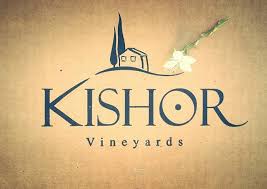
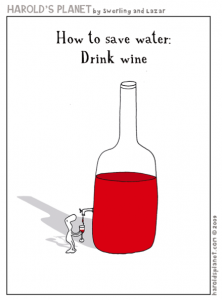 If encouraging good deeds sounds as good a reason as any, this week’s winery is certainly up your alley. Engaging in pure Tikun Olam on an industrial scale, Kishor Vineyards is producing lovely, well-balanced and delicious wines whose humble nature belies their underlying quality. Founded in 2010, Kishor Vineyards is located in Kishorit, home to 171 adults with special needs (plus 175 staff members).
If encouraging good deeds sounds as good a reason as any, this week’s winery is certainly up your alley. Engaging in pure Tikun Olam on an industrial scale, Kishor Vineyards is producing lovely, well-balanced and delicious wines whose humble nature belies their underlying quality. Founded in 2010, Kishor Vineyards is located in Kishorit, home to 171 adults with special needs (plus 175 staff members). Encouraged by current winemaker Richard Davis, the first vineyards were planted in 2007, the winery was “founded” in 2009 and made its first wine for the 2010 vintage (at which point it was already profitable, no mean feat for any vineyard – let alone a newly launched one). Originally from South Africa, Richard is a lovely person – big bearded with an easy smile, ready laugh and affable manner. He moved to Israel at the age of 21 with a plan to study agriculture and work the land. Hearing about Kishorit in passing, Richard was intrigued and came with the intention of volunteering at this special place for a few months – that was 11 years ago. Working on Kishorit’s various agricultural projects, the winery may never have come into being if not for the Second Lebanon War, which took place in the first half of 2006. Located just a few miles from the Lebanese border, the village’s infrastructure lacked sufficient bomb shelter space for all its residents. During a fundraising campaign to build additional bomb shelters, a wealthy British donor fell in love with Kishorit’s concept but wanted his significant contribution used to create a new industry that could also be a tourist attraction. A winery being the obvious choice, they were off to the races.
Encouraged by current winemaker Richard Davis, the first vineyards were planted in 2007, the winery was “founded” in 2009 and made its first wine for the 2010 vintage (at which point it was already profitable, no mean feat for any vineyard – let alone a newly launched one). Originally from South Africa, Richard is a lovely person – big bearded with an easy smile, ready laugh and affable manner. He moved to Israel at the age of 21 with a plan to study agriculture and work the land. Hearing about Kishorit in passing, Richard was intrigued and came with the intention of volunteering at this special place for a few months – that was 11 years ago. Working on Kishorit’s various agricultural projects, the winery may never have come into being if not for the Second Lebanon War, which took place in the first half of 2006. Located just a few miles from the Lebanese border, the village’s infrastructure lacked sufficient bomb shelter space for all its residents. During a fundraising campaign to build additional bomb shelters, a wealthy British donor fell in love with Kishorit’s concept but wanted his significant contribution used to create a new industry that could also be a tourist attraction. A winery being the obvious choice, they were off to the races. consultants, Itay also teaches winemaking at Tel Chai) and retain one of the countries best vineyard specialists (Benny Sorkin) to tend the vineyards. Like most Israeli wineries, initial plantings focused on the noble Bordeaux varietals of Cabernet Sauvignon, Merlot, Cabernet Franc and Petit Verdot but the winery has more recently turned its eye to Rhone-Valley varietals deemed better suited to Israel’s Mediterranean climate (e.g. Syrah, Grenache, Mourvedre in addition to Sauvignon Blanc, Viognier and the incredible Riesling profiled in last week’s newsletter) and the winery’s current wines reflect these more recently planted Rhone varietals. A number of the vineyards are in the process of being replanted, as a majority are infected with the leaf-roll virus that has been the scourge of Israeli vineyards for years (more on that in a coming post to the Facebook page).
consultants, Itay also teaches winemaking at Tel Chai) and retain one of the countries best vineyard specialists (Benny Sorkin) to tend the vineyards. Like most Israeli wineries, initial plantings focused on the noble Bordeaux varietals of Cabernet Sauvignon, Merlot, Cabernet Franc and Petit Verdot but the winery has more recently turned its eye to Rhone-Valley varietals deemed better suited to Israel’s Mediterranean climate (e.g. Syrah, Grenache, Mourvedre in addition to Sauvignon Blanc, Viognier and the incredible Riesling profiled in last week’s newsletter) and the winery’s current wines reflect these more recently planted Rhone varietals. A number of the vineyards are in the process of being replanted, as a majority are infected with the leaf-roll virus that has been the scourge of Israeli vineyards for years (more on that in a coming post to the Facebook page). Kishor Vineyards, Kerem Kishor, Rosé, 2017: Picked early from grapes specially allocated to make rosé, a blend of 40% Cabernet Franc and 60% Grenache fermented in neutral oak barrels. Bright, fresh notes of summer red fruit, citrus, sun-kissed Mediterranean herbs and summer fruits, the wine’s balancing acidity and biting minerals makes it a great summer quaffer while the winery’s personal story makes it an easy buy.
Kishor Vineyards, Kerem Kishor, Rosé, 2017: Picked early from grapes specially allocated to make rosé, a blend of 40% Cabernet Franc and 60% Grenache fermented in neutral oak barrels. Bright, fresh notes of summer red fruit, citrus, sun-kissed Mediterranean herbs and summer fruits, the wine’s balancing acidity and biting minerals makes it a great summer quaffer while the winery’s personal story makes it an easy buy. Kishor Vineyards, Misgav, Riesling, Off-Dry, 2017: This is the off-dry version which the winery has been making for a few years (starting with the inaugural 2014 vintage). Like the dry version, the wine is made from 100% unoaked Riesling and is loaded with vibrant yellow citrus, white flowers, a touch of spices and flinty minerals with saline nuances. Additional orange citrus combine with a whiff of petrol, with a sweet spark providing contra and balanced out with crisp acidity. 12% AbV. Drink now through 2010 [Only in Israel].
Kishor Vineyards, Misgav, Riesling, Off-Dry, 2017: This is the off-dry version which the winery has been making for a few years (starting with the inaugural 2014 vintage). Like the dry version, the wine is made from 100% unoaked Riesling and is loaded with vibrant yellow citrus, white flowers, a touch of spices and flinty minerals with saline nuances. Additional orange citrus combine with a whiff of petrol, with a sweet spark providing contra and balanced out with crisp acidity. 12% AbV. Drink now through 2010 [Only in Israel]. Kishor Vineyards, Kishor, GSM, 2015: A traditional Rhone blend of Grenache, Syrah and Mourvedre, each of which spent ten months in oak before being blended and spending an additional six months aging as the final blend. Expressive and powerfully aromatic nose with plums, cherries and other dark forest fruits along with a hint of blueberries, herbal notes and Oriental spices. Meaty tannins and black pepper are abundant on the medium-bodied palate with lovely earthy minerals, green nuance and spicy oak leading into a long, lingering and luxurious finish. 14% AbV. Drink now through 2019 [Shmita].
Kishor Vineyards, Kishor, GSM, 2015: A traditional Rhone blend of Grenache, Syrah and Mourvedre, each of which spent ten months in oak before being blended and spending an additional six months aging as the final blend. Expressive and powerfully aromatic nose with plums, cherries and other dark forest fruits along with a hint of blueberries, herbal notes and Oriental spices. Meaty tannins and black pepper are abundant on the medium-bodied palate with lovely earthy minerals, green nuance and spicy oak leading into a long, lingering and luxurious finish. 14% AbV. Drink now through 2019 [Shmita].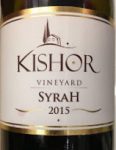 Kishor Vineyards, Kishor, Syrah, 2015: A great example of how wonderful Israeli Syrah used to be, especially with the lovely Israeli twist of cedar wood and fresh-rolled cigars. The wine is 100 % Syrah and spent 14 months in French oak. Loaded with rich dark plums, red fruit and warm spices, along with fresh-cracked black pepper, meaty tannins, pencil shavings, a bitter herbal overlay and rich earthy mineral notes, the wine clocks in at 14% AbV. Good balancing acidity and robust tannins provide structure and balance to the deep fruit and nuanced spicy complexity, all on a medium to full-bodied lush palate that leads into a long-lingering and ample finish. Well-priced, the wine is a high QPR value as well. Drink now through 2020 [Shmita].
Kishor Vineyards, Kishor, Syrah, 2015: A great example of how wonderful Israeli Syrah used to be, especially with the lovely Israeli twist of cedar wood and fresh-rolled cigars. The wine is 100 % Syrah and spent 14 months in French oak. Loaded with rich dark plums, red fruit and warm spices, along with fresh-cracked black pepper, meaty tannins, pencil shavings, a bitter herbal overlay and rich earthy mineral notes, the wine clocks in at 14% AbV. Good balancing acidity and robust tannins provide structure and balance to the deep fruit and nuanced spicy complexity, all on a medium to full-bodied lush palate that leads into a long-lingering and ample finish. Well-priced, the wine is a high QPR value as well. Drink now through 2020 [Shmita]. Kishor Vineyards, Misgav (Savant), Red, 2014: A blend of 80% Cabernet Sauvignon fleshed out with Merlot and Petit Verdot which spent a year in oak granting it lovely smoky notes. Nicely integrating tannins provide ample plush background for the rich yet controlled fruit that avoids the traditional Israeli trap of overripe sweet fruit. Elegant and well-balanced with well integrated plush tannins providing ample support for the fruit and balancing earthy mineral notes. Subtle, modest and elegance make it great for enjoying with well-balanced meals. Drink now through 2022, maybe longer.
Kishor Vineyards, Misgav (Savant), Red, 2014: A blend of 80% Cabernet Sauvignon fleshed out with Merlot and Petit Verdot which spent a year in oak granting it lovely smoky notes. Nicely integrating tannins provide ample plush background for the rich yet controlled fruit that avoids the traditional Israeli trap of overripe sweet fruit. Elegant and well-balanced with well integrated plush tannins providing ample support for the fruit and balancing earthy mineral notes. Subtle, modest and elegance make it great for enjoying with well-balanced meals. Drink now through 2022, maybe longer.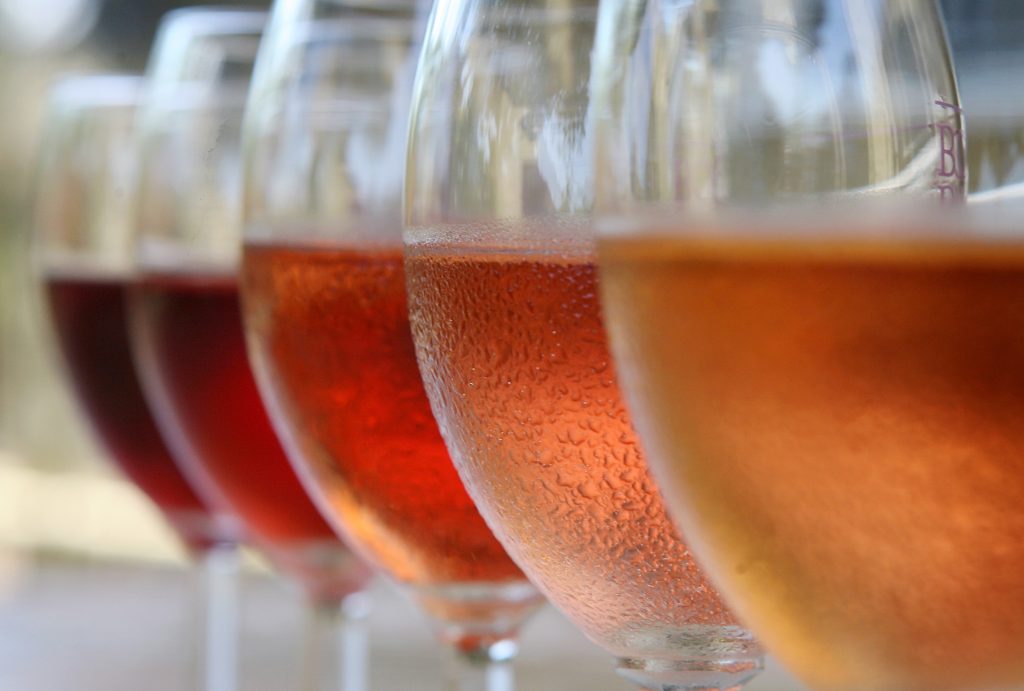
 Before we get into what exactly rosé is all about, there are a few important comments about the general state of rosé in the kosher wine market that should directly influence your buying habits this season. While a step or two behind the general wine world’s current trends, rose’s exploding popularity continues seemingly unabated. After a nearly 50% increase in the number of rosé wines I tasted for last year’s newsletter, this year saw a further increase of over 20% as I doggedly tracked down and tasted 93 different rosé wines from around the world (even so, a few eluded me). An abundance of choices is usually good for the consumer, not only due because it caters to an increasingly growing number of palate preferences but also usually leads to a decrease in prices. However, in our case, rosé’s popularity has encouraged every winery to get in the game, regardless of whether raw materials (grapes), knowledge or experience are sufficiently present. Additionally (and beyond the simple havoc being wreaked on the consumer’s decision making process), surging demands has enabled wineries to partake in such extreme levels of chutzpadik pricing as to simply boggle the mind (first time Israeli rosé producer charging $40 – I’m talking to you).
Before we get into what exactly rosé is all about, there are a few important comments about the general state of rosé in the kosher wine market that should directly influence your buying habits this season. While a step or two behind the general wine world’s current trends, rose’s exploding popularity continues seemingly unabated. After a nearly 50% increase in the number of rosé wines I tasted for last year’s newsletter, this year saw a further increase of over 20% as I doggedly tracked down and tasted 93 different rosé wines from around the world (even so, a few eluded me). An abundance of choices is usually good for the consumer, not only due because it caters to an increasingly growing number of palate preferences but also usually leads to a decrease in prices. However, in our case, rosé’s popularity has encouraged every winery to get in the game, regardless of whether raw materials (grapes), knowledge or experience are sufficiently present. Additionally (and beyond the simple havoc being wreaked on the consumer’s decision making process), surging demands has enabled wineries to partake in such extreme levels of chutzpadik pricing as to simply boggle the mind (first time Israeli rosé producer charging $40 – I’m talking to you).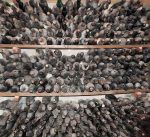 Further complicating issues is the amount of 2016 vintage rosé being pushed on unsuspecting consumers. Notwithstanding the success of Maria Jose Lopez in creating ageable rosé for
Further complicating issues is the amount of 2016 vintage rosé being pushed on unsuspecting consumers. Notwithstanding the success of Maria Jose Lopez in creating ageable rosé for  I usually try to get my newsletter on summer’s wine out the door before the season officially opens on America’s Memorial Day. However (and similar to last year’s predicament), the monumental number of available wines and their widely disparate geographic distribution ensured that completing the arduous task of tasting them all took longer than expected (I would be remiss if I didn’t publicly thank all my generous mules- tremendously appreciated). Rosé’s surging popularity has helped breach the formerly impregnable walls of even the most stubborn “red wine only” proponents who have reluctantly incorporated rosé into their summer repertoire. In order to service this growing market, producers are investing more time, effort and money in crafting higher quality rosé wines (with mixed results). Some of these efforts include designating specific plots specifically for rosé production (instead of simply using excess or lesser grapes) and earlier harvesting to ensure lower residual sugar and higher acidity. While the resulting corresponding increase in pricing was to be expected, it’s nonetheless unfortunate that the average price of the ultimate summer quaffer has climbed to a range of $25-$35 for most quality options (with many lacking the basic “quality” characteristic), which is an unacceptable price range. Given the lack of depth and sophistication and general “quencher” aspect of these wines, anything over $25 (more appropriately $20) is simply criminal. As a point of comparison, there are abundant non-kosher rosé options under $10, many of which are the qualitative equals of the higher-end kosher options whose average price is now north of $30. While I appreciate the commercial validity of giving consumers the options they seek, in the case of wineries producing a higher-end rosé in addition to their regular option (e.g. Château Roubine, Dalton La Citadelle de Diamant, Netofa, Recanati and Tabor), I find it defeats the purpose and almost always fails to meet the stated expectations.
I usually try to get my newsletter on summer’s wine out the door before the season officially opens on America’s Memorial Day. However (and similar to last year’s predicament), the monumental number of available wines and their widely disparate geographic distribution ensured that completing the arduous task of tasting them all took longer than expected (I would be remiss if I didn’t publicly thank all my generous mules- tremendously appreciated). Rosé’s surging popularity has helped breach the formerly impregnable walls of even the most stubborn “red wine only” proponents who have reluctantly incorporated rosé into their summer repertoire. In order to service this growing market, producers are investing more time, effort and money in crafting higher quality rosé wines (with mixed results). Some of these efforts include designating specific plots specifically for rosé production (instead of simply using excess or lesser grapes) and earlier harvesting to ensure lower residual sugar and higher acidity. While the resulting corresponding increase in pricing was to be expected, it’s nonetheless unfortunate that the average price of the ultimate summer quaffer has climbed to a range of $25-$35 for most quality options (with many lacking the basic “quality” characteristic), which is an unacceptable price range. Given the lack of depth and sophistication and general “quencher” aspect of these wines, anything over $25 (more appropriately $20) is simply criminal. As a point of comparison, there are abundant non-kosher rosé options under $10, many of which are the qualitative equals of the higher-end kosher options whose average price is now north of $30. While I appreciate the commercial validity of giving consumers the options they seek, in the case of wineries producing a higher-end rosé in addition to their regular option (e.g. Château Roubine, Dalton La Citadelle de Diamant, Netofa, Recanati and Tabor), I find it defeats the purpose and almost always fails to meet the stated expectations. With our litany of complaints out of the way, we can now turn to the positive aspects – namely the wine itself and the pleasure it can bring us all. Rosé wines are made using a number of different techniques and its name (French for pink) encompasses all wines falling between red and white on the color spectrum. The method that typically produces the highest quality rosé is maceration, in which the juice of red grapes “sits” on its peel for a short period of time (typically a few hours to a few days) and then the skins are discarded. Remember, with only
With our litany of complaints out of the way, we can now turn to the positive aspects – namely the wine itself and the pleasure it can bring us all. Rosé wines are made using a number of different techniques and its name (French for pink) encompasses all wines falling between red and white on the color spectrum. The method that typically produces the highest quality rosé is maceration, in which the juice of red grapes “sits” on its peel for a short period of time (typically a few hours to a few days) and then the skins are discarded. Remember, with only 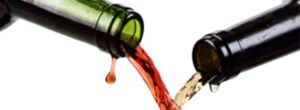 Another, far less common and barely worth even mentioning, production method is blending red and white wines. Other than with respect to the cheapest and most commercialized of wines, this methodology is primarily used to make Champagne, where Pinot Noir is added to a Chardonnay base to create the sexiest of all wines – rosé Champagne (or its non-Champagne equivalent – rosé sparkling wine). While exceptionally rare, the maceration method is sometimes used to create rosé sparkling wine by allowing Pinot Noir grapes very brief skin contact during fermentation and avoiding the need to blend them with Chardonnay.
Another, far less common and barely worth even mentioning, production method is blending red and white wines. Other than with respect to the cheapest and most commercialized of wines, this methodology is primarily used to make Champagne, where Pinot Noir is added to a Chardonnay base to create the sexiest of all wines – rosé Champagne (or its non-Champagne equivalent – rosé sparkling wine). While exceptionally rare, the maceration method is sometimes used to create rosé sparkling wine by allowing Pinot Noir grapes very brief skin contact during fermentation and avoiding the need to blend them with Chardonnay. Whenever possible, I taste wines over a long period of time (18-36 hours), with varying amounts of air (pop & pour, aerators, decanting) and at different temperatures (38º (refrigerator) -55º (cellar) – 70º (room)). I do this for the same reason that I try and purchase every wine from a retailer before I release a tasting note – to ensure that my experience / tasting notes resembles, reflects as closely as possible, the circumstances under which my readers will experience the wine. While not the optimal temperature, its position as fun, guilt-free, summer dictates that the vast majority of rosé to be popped and poured directly from the refrigerator they were chilling in at the icy temperature of 38ºF (~3.5ºC). As such, a fair number of options didn’t make the list since they required much more care and handling then I expect they will get. Some wines were only able to reveal their charms after excessive airtime (24-36 hours), while others required temperatures in excess of 60º before they provided sufficient pleasure to be considered for this list; both conditions unlikely to be afforded most of the rosé consumed this summer.
Whenever possible, I taste wines over a long period of time (18-36 hours), with varying amounts of air (pop & pour, aerators, decanting) and at different temperatures (38º (refrigerator) -55º (cellar) – 70º (room)). I do this for the same reason that I try and purchase every wine from a retailer before I release a tasting note – to ensure that my experience / tasting notes resembles, reflects as closely as possible, the circumstances under which my readers will experience the wine. While not the optimal temperature, its position as fun, guilt-free, summer dictates that the vast majority of rosé to be popped and poured directly from the refrigerator they were chilling in at the icy temperature of 38ºF (~3.5ºC). As such, a fair number of options didn’t make the list since they required much more care and handling then I expect they will get. Some wines were only able to reveal their charms after excessive airtime (24-36 hours), while others required temperatures in excess of 60º before they provided sufficient pleasure to be considered for this list; both conditions unlikely to be afforded most of the rosé consumed this summer.